Affectionately known as the “Porkies,” this Lake Superior wilderness in Michigan’s Upper Peninsula boasts the largest primary stand of hemlock in the Great Lakes along with hundreds of cascades on volcanic rock.
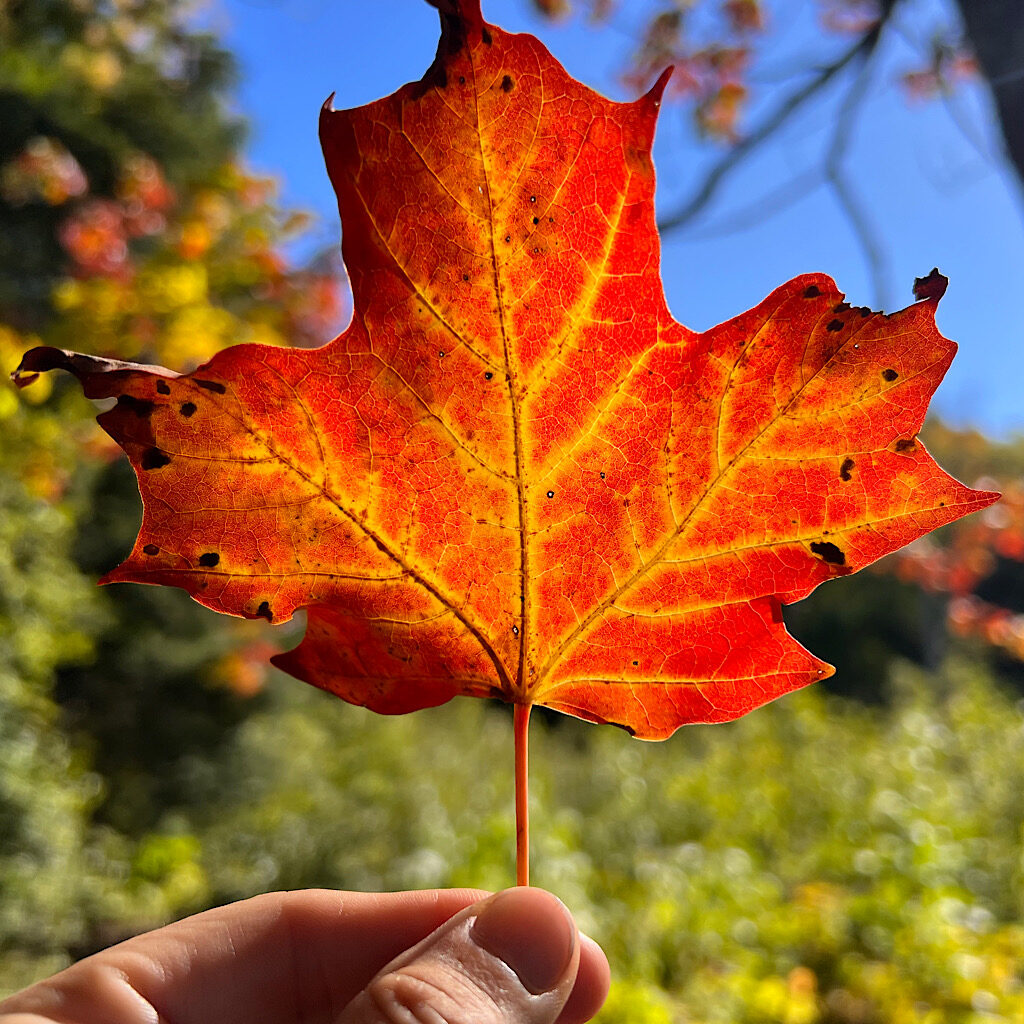
animal chorus
I crawl into the alicoop – my tent – before it goes completely dark, watching the rays of sunlight pierce the thick forest, creeping slowly into open areas and leaving long shadows on a beaver pond reflecting the brilliant red of autumn. Squeaks and chirrups fill the canopy, ones I quickly learn may sound like birds but are actually chipmunks, busily collecting and stashing food before this brilliant Indian Summer gives way to a long, harsh winter.
They’ve become my companions on my three-day backpack trip in Porcupine Mountains Wilderness State Park, scurrying across the trail then stopping to give me a sidelong stare, their fleecy tails quivering before they dart away.
I wonder if my food bag is safely out of reach hanging from a metal bear pole. Couldn’t they just launch from the hemlock brushing its sleek side, grab the bag and begin chewing it open? Unlikely. What’s left of my food is wrapped in ziplocs, inside a thick odor-proof bag, and inside yet another bag with a weave like kevlar. Still, one fearless chipmunk poses on a nearby stump only a few feet from my head, his black lashed eyes looking deep into mine as if to say, C’mon, you know I’m cute and want to feed me.
Sorry, pal, all my food is hanging on that pole and besides, I’m laying down now at the end of a good, long day of walking and not about to get up. So he joins his friends who are joined by others as if to reprimand or entertain – a couple of howling wolves, a barred owl’s who cooks for you, who cooks for you-alllll, and what seems like non-stop slaps kersplash! from a set of hard-working beavers long after the stars come out, so bright I see their reflection on the water.
Sleep matters, but I love the show – and that’s precisely why I’m here.
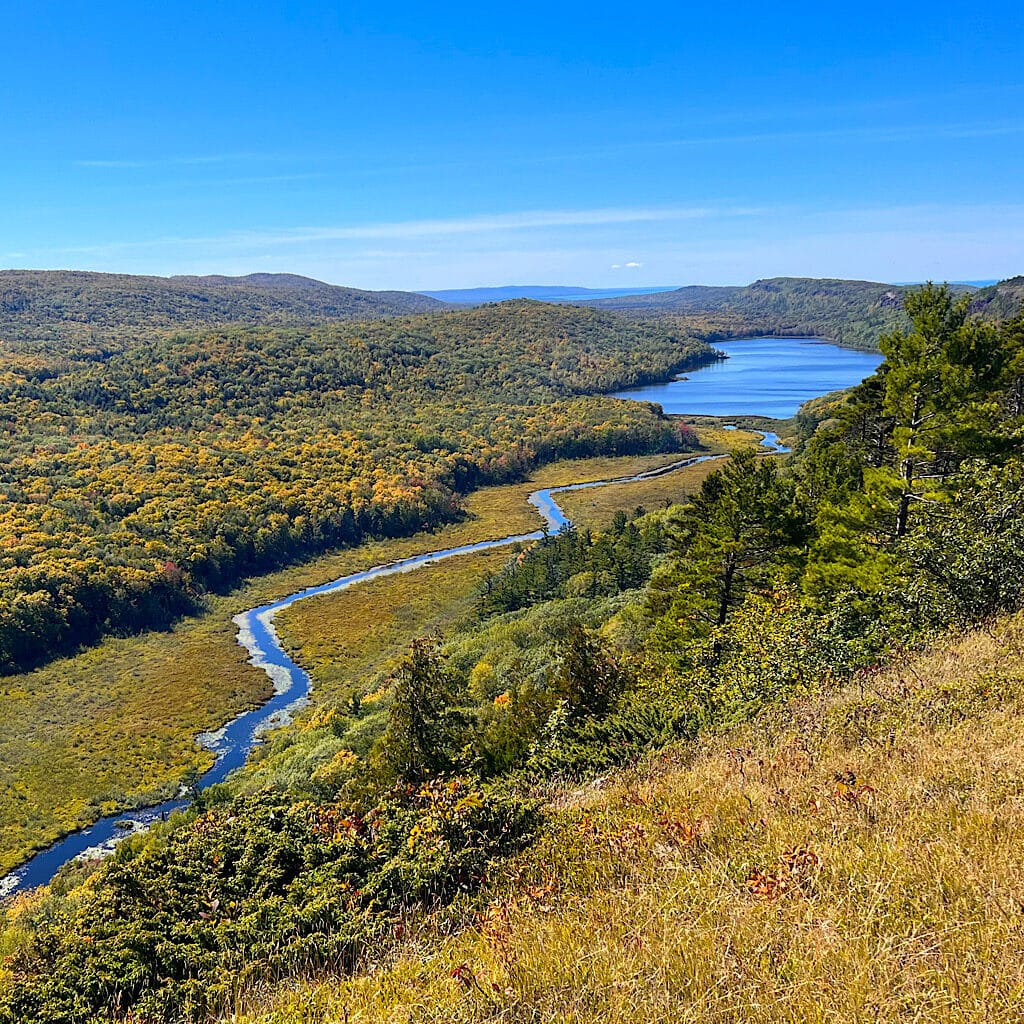
The best sky was in Italy and Spain and Northern Michigan in the fall.
Ernest Hemingway
the “Porkies”
The Porcupine Mountains, affectionately knows as the “Porkies,” abut Lake Superior on the northwestern part of Michigan’s Upper Peninsula. The park was established in 1945 to save the largest primary stand of hemlock and hardwood in the Great Lakes, 35,000 acres to be exact. Untouched virgin woodland is tucked deep under an escarpment of volcanic basalt that rises abruptly from the lake. It’s perfectly situated as if a viewing platform to this “forest museum,” one filled with an ecologically diverse system including gray wolf and coyote, beaver and otter, fisher, marten, and minks, bobcats, lynx and cougar, 200 black bears, and, of course, porcupines.
Environmentalist and conservationist Aldo Leopold wrote, “The richest values of wilderness lie not in the days of Daniel Boone, nor even the present, but rather in the future.” He joined efforts underway to save this strikingly beautiful mountainous piece of land, the highest between the Alleghenies of West Virginia and South Dakota’s Black Hills. Retrieving it from timber and mining companies cost the state a million dollars, about $21-million in today’s dollars.
Nearly thirty years after the park was founded, the state of Michigan created a Wilderness Act that gave the park a new designation along with ninety miles of trails (part of which is shared with the North Country Trail), backcountry campsites and cabins along with interpretive centers and easy access to the highlights by road, including Lake of the Clouds and the Summit Peak Observation Tower.
For me, it was a chance to backpack close to home (a five-hour drive from Saint Paul) and take in fall in all of its heavenly beauty, enjoying forests and lakes as well as a feature I was unaware of before – hundreds of water falls and rapids made up of crystal clear water shooting down billion-year-old rock beneath piney boughs, a subtle and smaller-scale pleasure from the Rocky Mountains, Sierra or Alps but one that surprised and delighted me to my core.
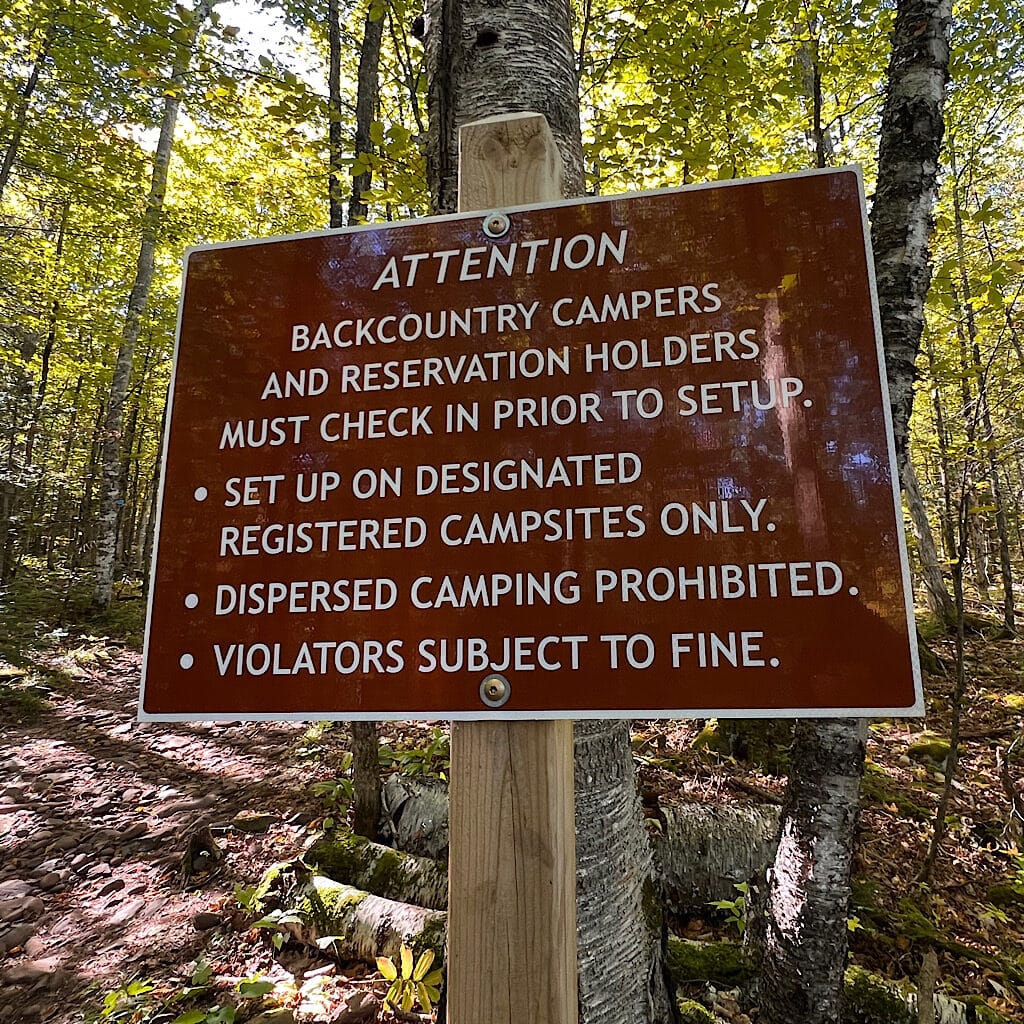
logistics
I am not a person who meticulously plans every hike. Sure, I pull together maps, check the average temperatures and historic weather patterns, pack the right gear and food, consider escape routes, etc. so when I learned that I had to reserve specific campsites ahead of time for this backpack trip, I was slightly annoyed. I love the freedom of not knowing where I’ll stay each night, walking as far or as little as I want to go and letting the day unfold.
That was not to be the case this time around. Though it turns out for good reason. Overcrowding and campers definitely leaving a trace led the park supervisors to limit the number of hikers to designated campsites, no longer allowed “dispersed camping.” The good news is I’d know where I’d end up, have it all to myself and that there would be a flat spot to set the alicoop. The bad news is I had no idea where I wanted to go.
That’s when I decided to call the park and ask. And who would answer the phone but Katie Urban, Park Interpreter. Katie was amazing. She obviously loves the park and gave me good advice on how to create a hiking loop as well as listing some of her favorite sites (and those to avoid which included most of the lakefront due to deep mud) The most critical bit of information she shared was that, unlike national parks, the Porkies does not have a policy of holding back permits for walks-ups. Once a site is reserved, it’s gone, and while I was hiking mid-week, my trip was smack dab in the middle of “leaf peeping” season and the park could fill fast.
Katie gave me courage – and a nudge – to get my act together a few weeks before heading up. I found the reservation website manageable, but the cost a bit steep – $20 per night plus an $8 service charge. This trip was getting spendy! Even after I clicked purchase, my receipt was not a permit and required picking up at the Visitor Center where a ranger would presumably detail all regulations and requirements before I could start walking.
I took my time before pressing purchase, though, to be certain I made the best choices because there’s quite a complicated cancellation policy. I have gone ahead and included it below so you can share in the irritation amusement…
Customers may change or cancel a reservation through the reservation call center or online with a registered account. The reservation fee is non-refundable and additional cancel fees will apply. After the date a campsite reservation is created, it cannot be cancelled or modified more than 5 months prior to the arrival date. If a reservation is cancelled, or modified by shortening the stay, the following fees will be assessed:$10 cancel/modification fee, and, a percentage of the value of eligible unused camp night fees, based on number of months the reservation has been held, from 10% of the value of the eligible nights for reservations changed or cancelled within 2 months of the reservation creation date, up to 40% for reservations changed or cancelled more than 5 months after the reservation creation date. If cancelled on the day of arrival or later, the first night’s fee and the value of any additional past nights are forfeited. Reservations that are cancelled on the same day they are created will be assessed the $10 cancel/modification fee. Modifications to reservations that do not affect the length of stay, will only be assessed the $10 cancel/modification fee. Modifications to reservations that results in an increase in the length of stay, will NOT be charged a cancel/modification fee. No-Show Reservations are held until 3pm, two days after the scheduled arrival date. If not checked in, no-show reservations will be cancelled resulting in a loss of 2 nights fees. Any remaining unused nights will be eligible for refund less the percentage value indicated in the Cancellation/Modification Formula Chart. Once a booking has been checked in at the park, if a customer chooses to reduce their stay or check out early, the refund due will be the value of unused nights less the percentage value based on the original reservation creation date. A night is considered used if the check out occurs after 1pm on that date. Please check online for more information on reservation policies.
Good grief.
day one, Government Peak Trail Head to BC-3 – 6 miles
The Visitor Center is crowded, but Ranger Nickie gives me all the time I need for questions, underscoring the Artist-in-Residence program and my need to carry water on the escarpment since I won’t cross a stream for over nine miles.
I leave my car on the road finding the trailhead parking full and walk up a cobblestone path in a fresh, lake air-conditioned 46-degrees through a thick stained glass forest of crimson, amber and umber, chickadees clicking and shushing. A ruffed grouse, known also as a wood hen or partridge is in full camouflage making a racket as it squawk-flies through the thick understory.
It’s steep here and I use my poles to pull myself to my first view looking out across a tapestry of color. My feet move from crackling maple leaves to soft pine, even this close to the road, it’s silent except for the chips of a yellow-rumped warbler. The history of this place is all fire and ice, its geologic name of mid-continent drift seeming to portray a more casual leave-taking and nothing like the eruption of magma that occurred when the land was ripped in half.
Much of the Upper Great Lakes is tree-covered. Yes, there are millions of lakes including the Greats, and wisely the first peoples and subsequent trappers and traders used water as their super highways, avoiding the nearly impassable forests. Here, though, the rock of the Keewanawan Supergroup is exposed, and the edge, while steep, is easy to navigate opening to jaw-dropping views of a serpentine river feeding the lake beyond.
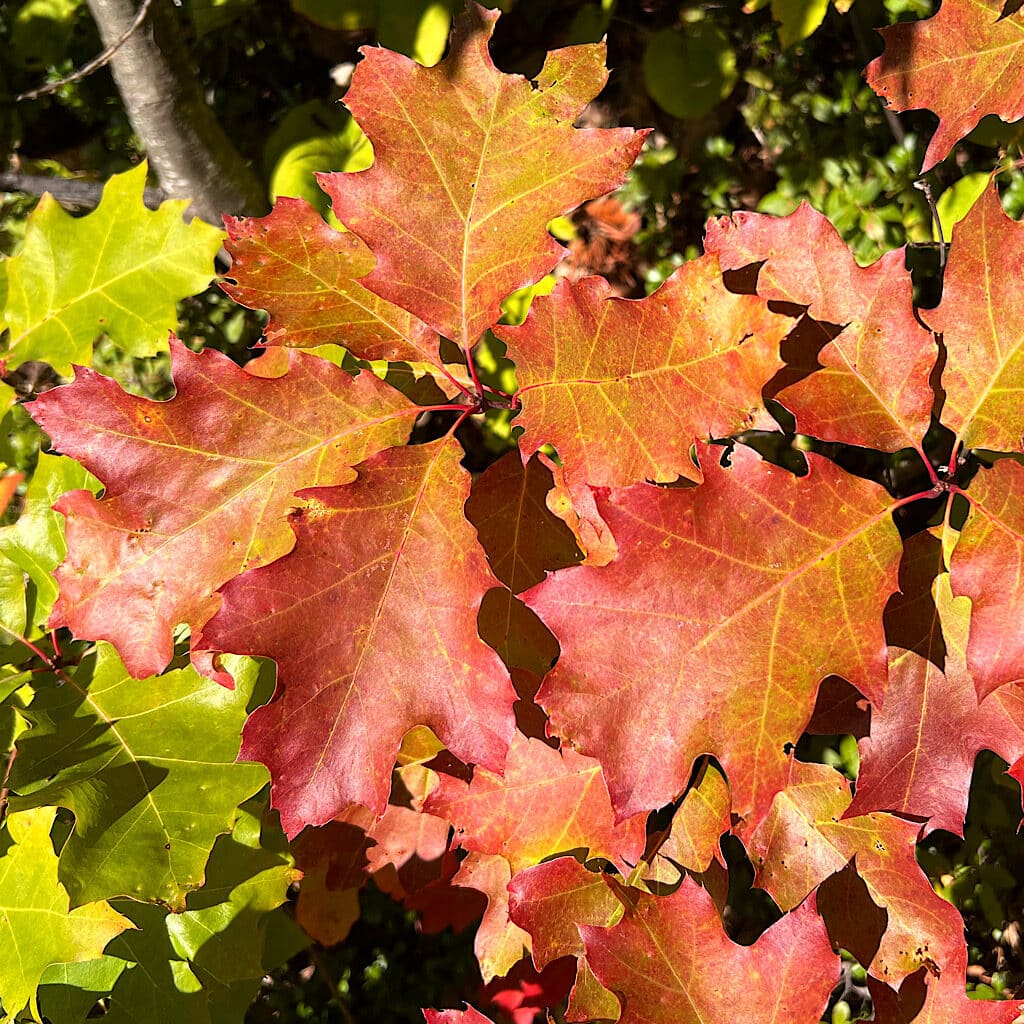
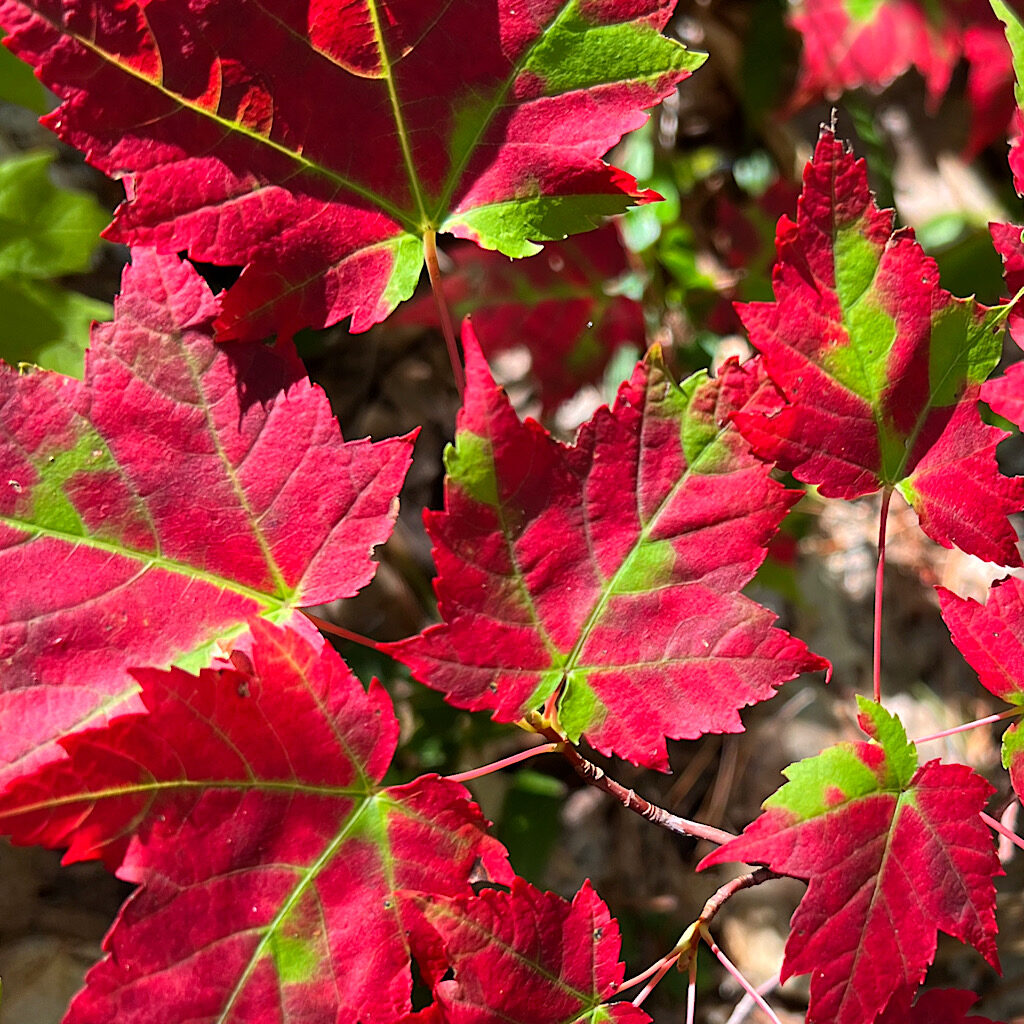
The trail rolls up and down following the ridge, sumac in a flaming crimson and low yellowing blueberry bushes free now of all fruit thicken the floor. Autumn is just starting to put on its finery in the North Woods, and random Sugar Maples stick out as if on fire, or maybe haphazardly painted a blinding red.
I meet a fellow backpacker named Tawnee carrying far too much but smiling just the same. Like me, she stops every few minutes to gawk and admire, taking picture after picture, trying to hold this moment forever. A pileated woodpecker, big and bold, its red cap vying for dominance in this red world, pushes itself off a tree trunk, laughs loudly then floats into the valley.
This is a good place to pause in the shade of white pine, clinging to the rock and bent by wind and weather. It’s cool out of the sun and everywhere is evidence of magma – rock full of holes breaking into geometric chunks. This is Lakeshore Traps Basalt, tilted bedrock above a shallow inland lake that gets its name from the fog blanketing it each morning. Now it’s a deep cobalt reflecting the nearly cloudless sky.
My walk today is short even if I get a late start – only six miles to my site with sunset around 8:00. Up and up I go high above, then down again meeting day hikers afraid to step on slippery dirt while descending. I reach out to help one like Katlyn helped me on the Wind River High Route and she smiles. “You’re sleeping out here tonight? How cool!”
More and more walkers pass coming from the parking lot nearby. A campsite sits close to the junction and I send a silent thank you to Katie for suggesting I camp further on. Here are stairs made of wood, making the walking easier and helping prevent erosion. It leads to a complex of decking allowing the scarred earth below from so many tourists to heal. Everyone is in a good mood, the warm air, the pungent, earthy smell and the soft colors a balm.
When I move on, a sign warns me again to ensure I have a permit to camp and that the trail ahead is rough. The last part is directed not so much at me, but at those wanting to venture on from the safety of the ADA compliant platform. It’s just a few more miles with views down to the outlet and more startlingly bright colors.
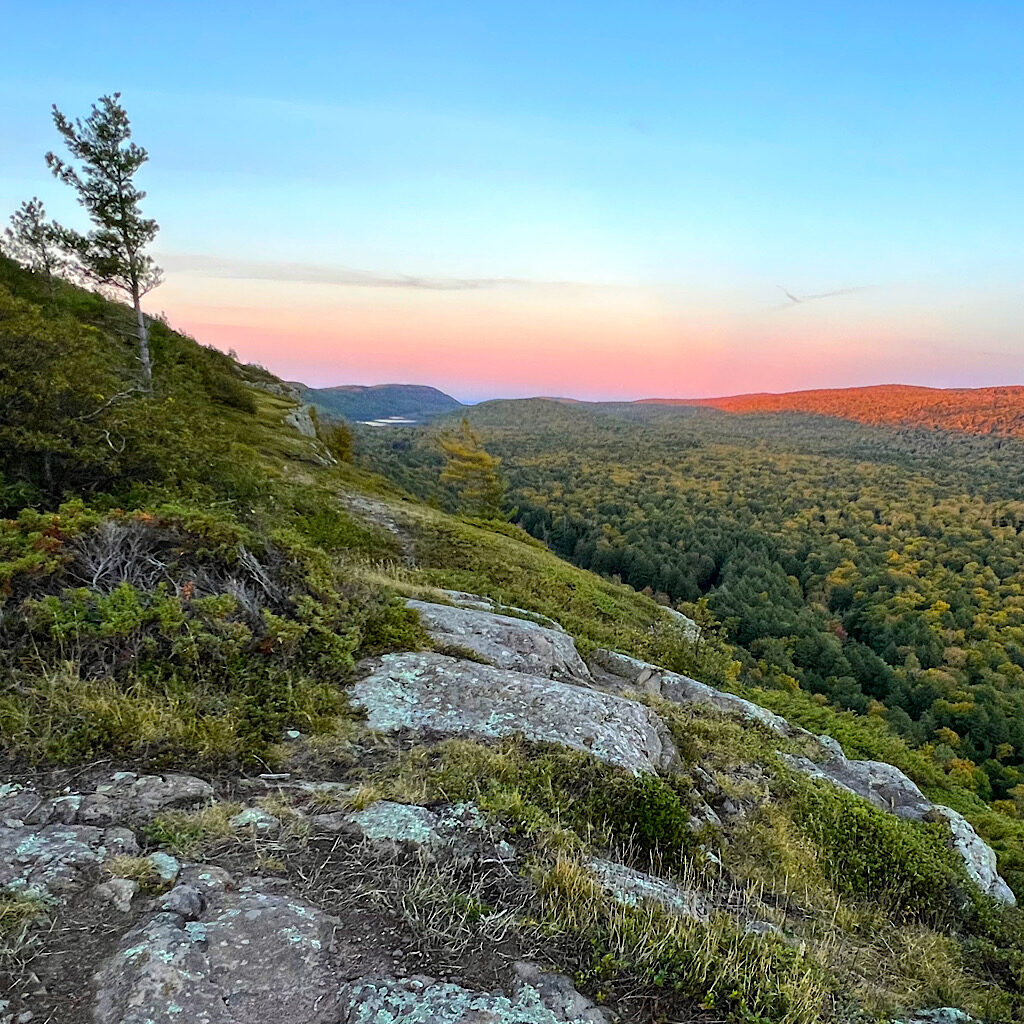
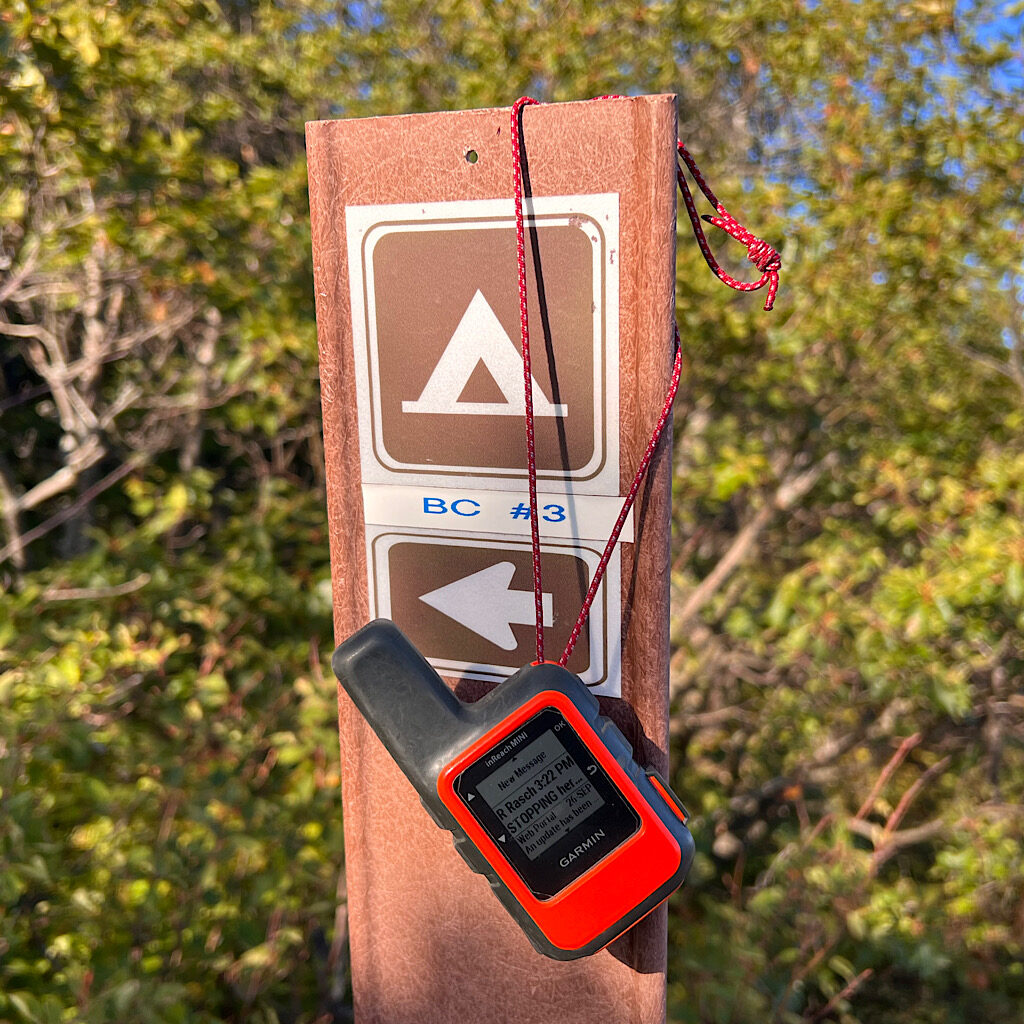
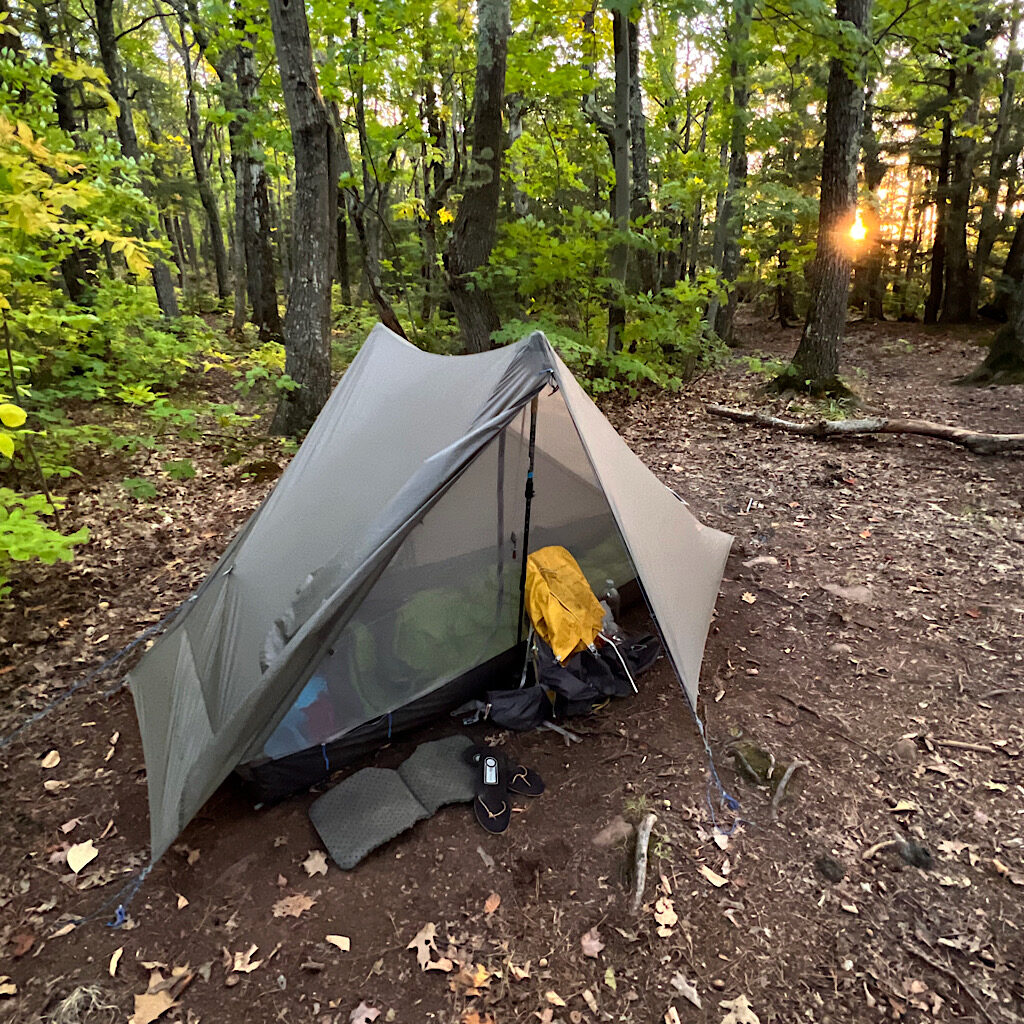
I meet a young backpacker planning to walk to his car and ask if he might share a bit of water since he’s headed out. I drink right from his bottle, squeezing river water into my mouth from the filter. I tell him i have enough, but a bit nervous with just the two liters. Truth is, I can’t comfortably carry much more, so try to “camel up” before walking. He assures me I have enough but is happy to share before racing on.
BC-1 has the camper directly on the ridge looking back at the lake. No wonder it was nabbed before I began planning. BC-2 sits back a bit with an apron of rock. When I reach mine, I see I’ll be setting inside the forest, but my site marks the end of the high trail with a long front deck looking deep into the forest, out towards the Big Lake and back.
The sun aims deeply into the woods, yellow and warm making long shadows. As I set, two Air National Guard jets fly over piercing the sky with an explosive boom. So much for wilderness. I set up my bear hang, then take dinner to my deck, white pine silhouetting the setting sun. I stay here as the sky becomes a watercolor of apricot and a silver sliver of moon peaks through wispy clouds.
Just then, a man crashes through the trees. He’s dressed in camo and tells me he lives in nearby Ontonagon. “I need to come out every week to see where the leaves have gotten to,” he tells me before loping back the way I came.
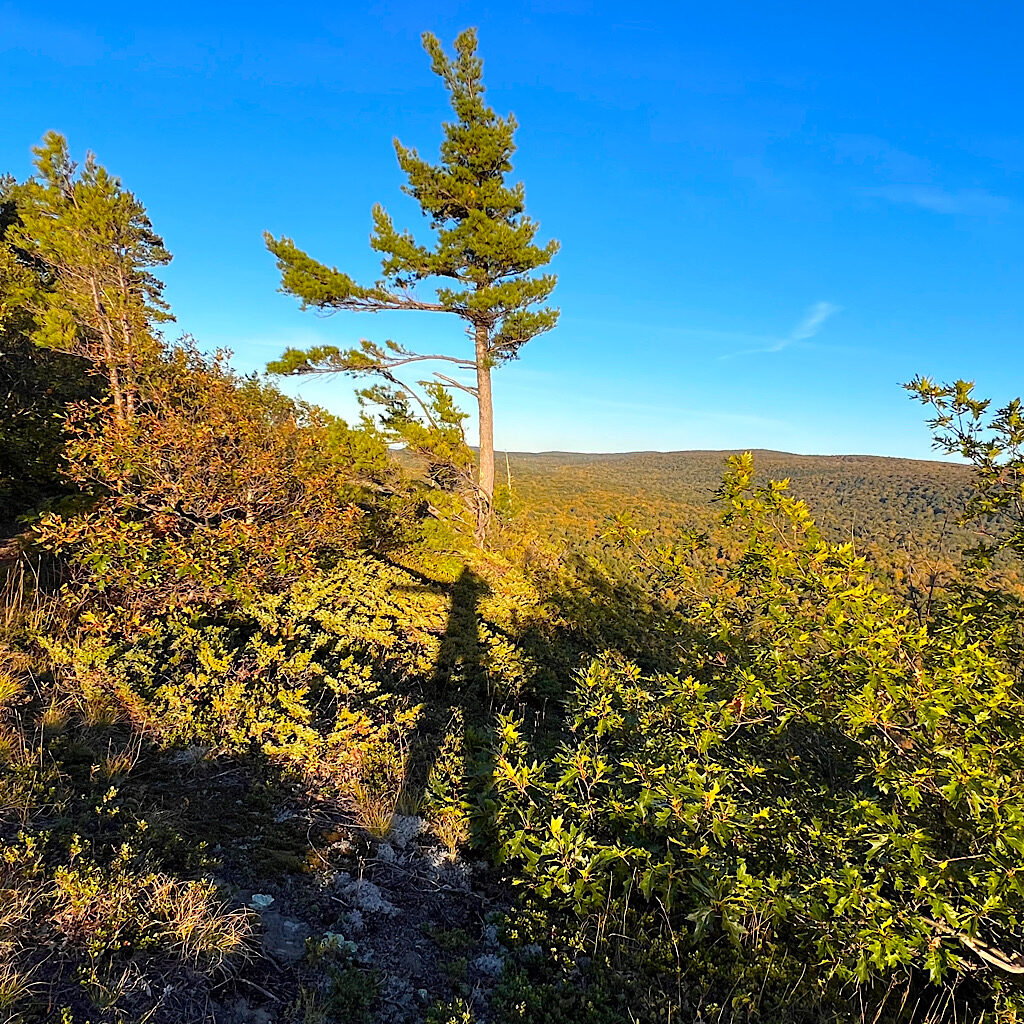
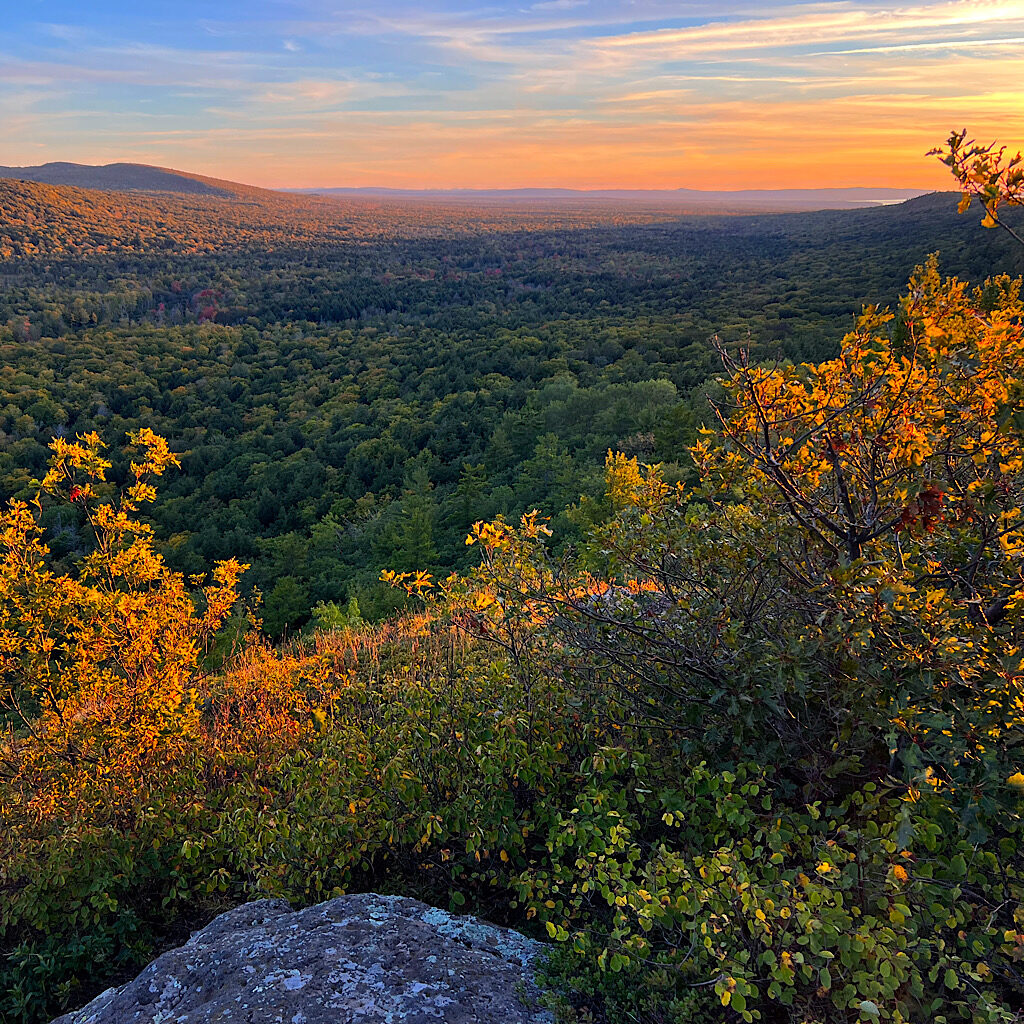
A barred owl’s call echoes below and a wolf barks low and long. Hermit thrushes chip as the magenta sky becomes a burnt sienna and the first star appears. I can’t leave as I think back on this day, the first where I’m still adjusting to what’s presented, not sure how fast to go or how long to stop. For a moment I feel uncertain in my choice of coming here even though I felt compelled to see what was so close to where I live and get inside it.
The wind picks up and the darkness deepens revealing the Milky Way. A tufted titmouse rasps his scrappy call as I crawl into bed unsure just how cold it could get tonight. I stuff my water filter and electronics inside my bag in case it freezes then lay back to sleep, tired from the long drive and walk.
Suddenly, I hear a crash. Hey! Silence. Then another crash, tentative and more like a rustling and crunching. Hey! Get outta here! I shine my light out onto an empty campsite, far too big for me alone. I find my food bag twisting solemnly in the breeze.
Nothing.
Another crash, and now it’s right at me. HEYYYY!
It’s an acorn. And then, another acorn. Let’s call it the attack of the killer acorns. OK, I think I can survive this war. Go to sleep, Blissful, you have another hiking day tomorrow.
day two, BC-3 to LC-7 – 14 miles
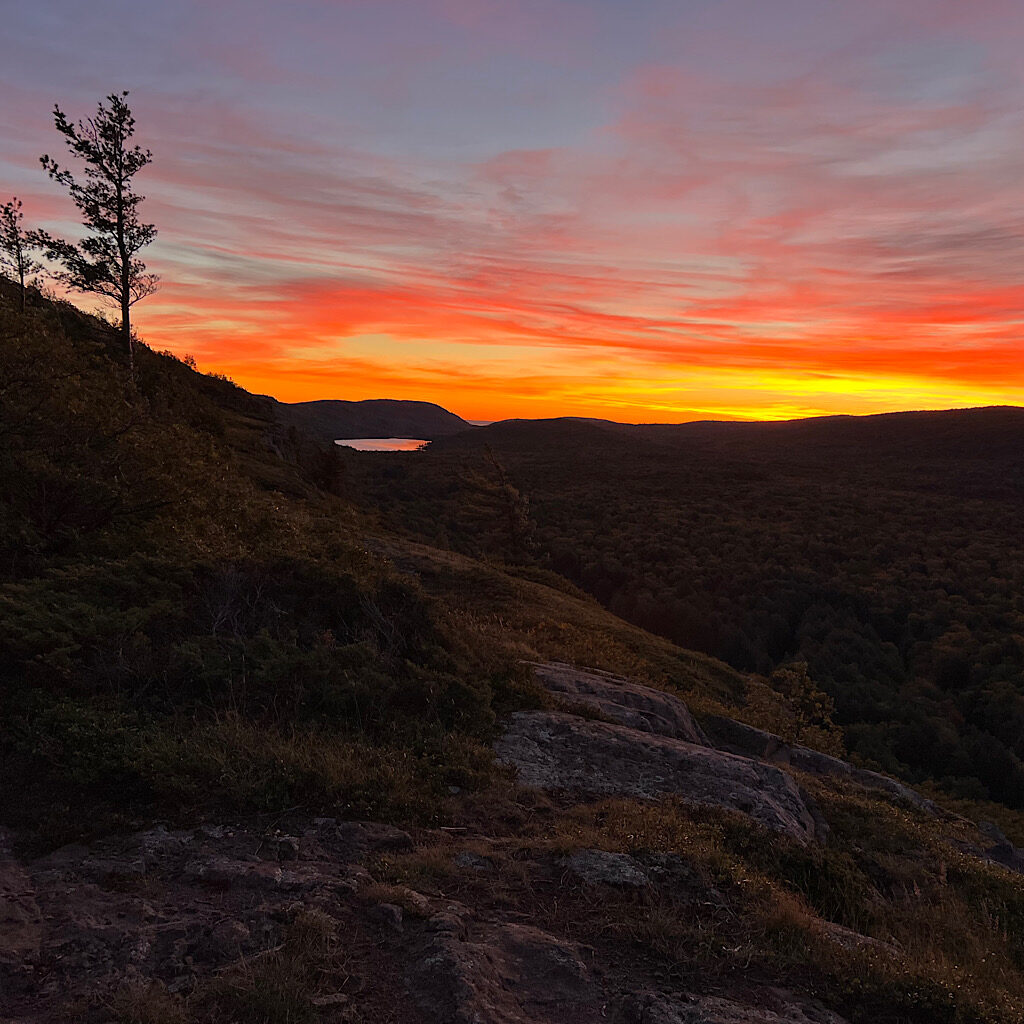
The acorns back off and let me sleep deeply before I crawl out to watch the sky turn orange – another tip from Katie, Park Interpreter that the sunrises are particularly special from up here. Feeling confident this will be an easy day of hiking, I crawl back in and fall asleep as the sun slowly filters in and I realize it’s a lot later than I thought.
Leaving the escarpment, I walk under 1,500-foot Cuyahoga Peak, a steep overhanging cliff of eroding talus bright in the sunlight. I enter my first Hemlock forest. The Eastern Hemlock or pruche du Canada is a long-living pine with gentle and soft needled branches gracefully fanning away from its giant trunk shedding tiny pine cones. Shade-tolerant and water-loving, they grow easily on slopes, straight up for 100 feet.
It feels primeval in here, the trees clearing the floor of most other plants except maidenhair ferns. It’s looks cultivated, though by the hands of a character from a fairy tale. The light filters differently from the hardwoods, the rays exposed in shafts of dust and mist. I walk on a shelf of land, flat and open. Squirrels chatter and a red tailed hawk shrieks. I am now in the forest museum, amongst its residents.
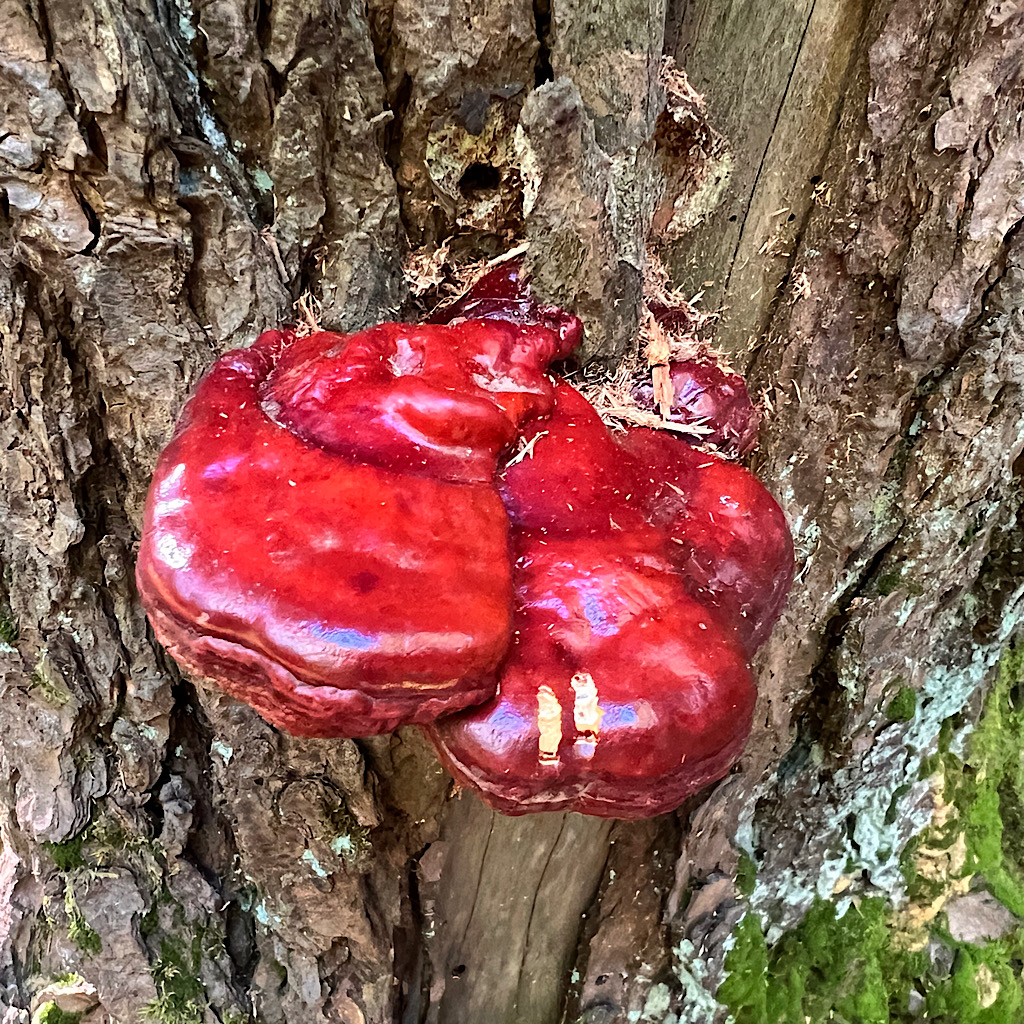
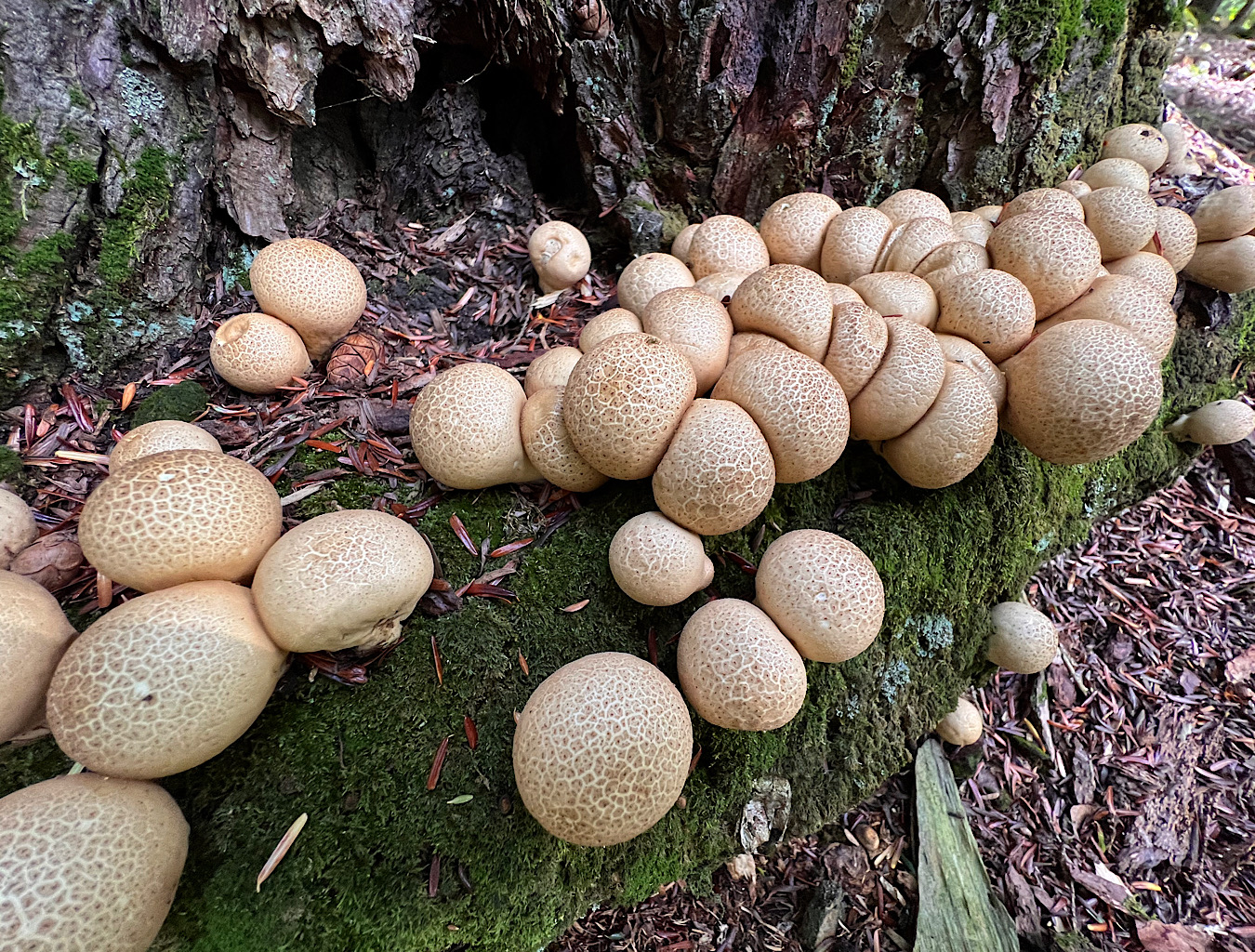
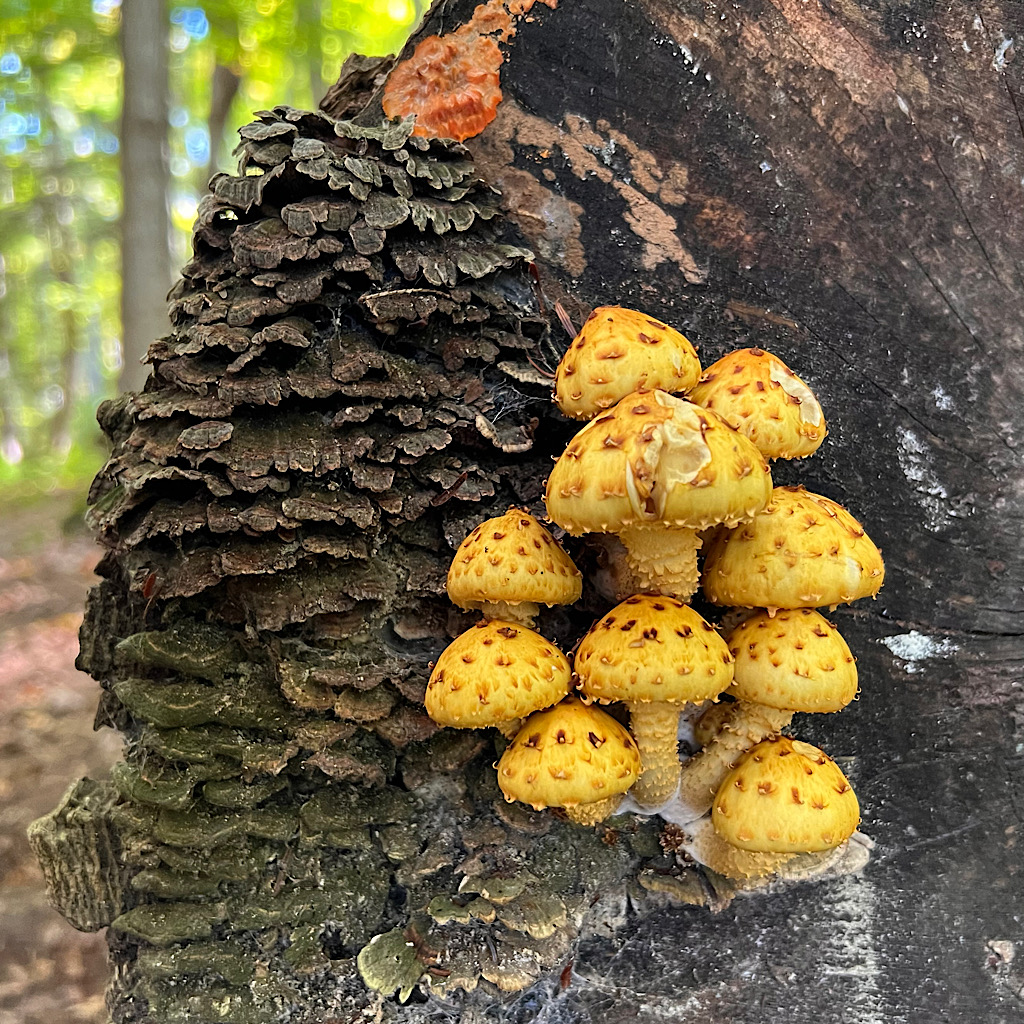
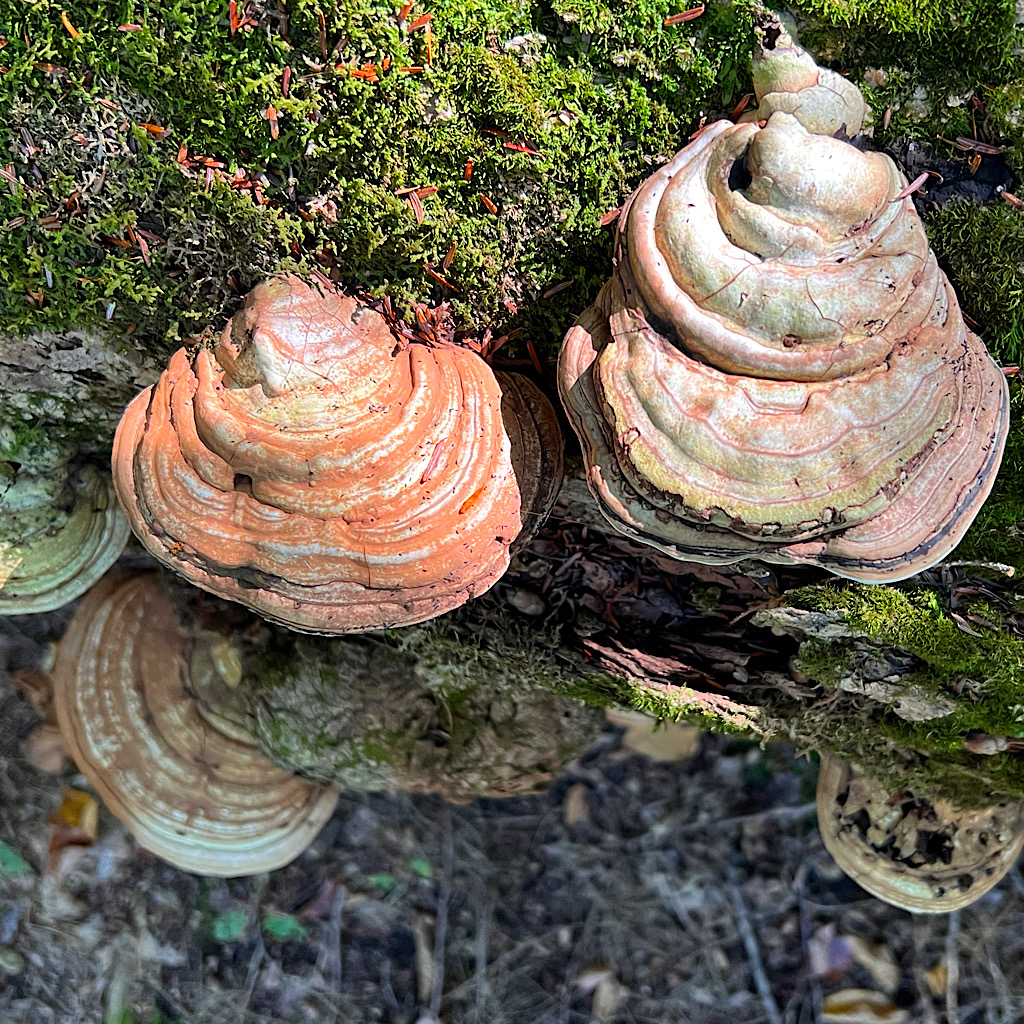
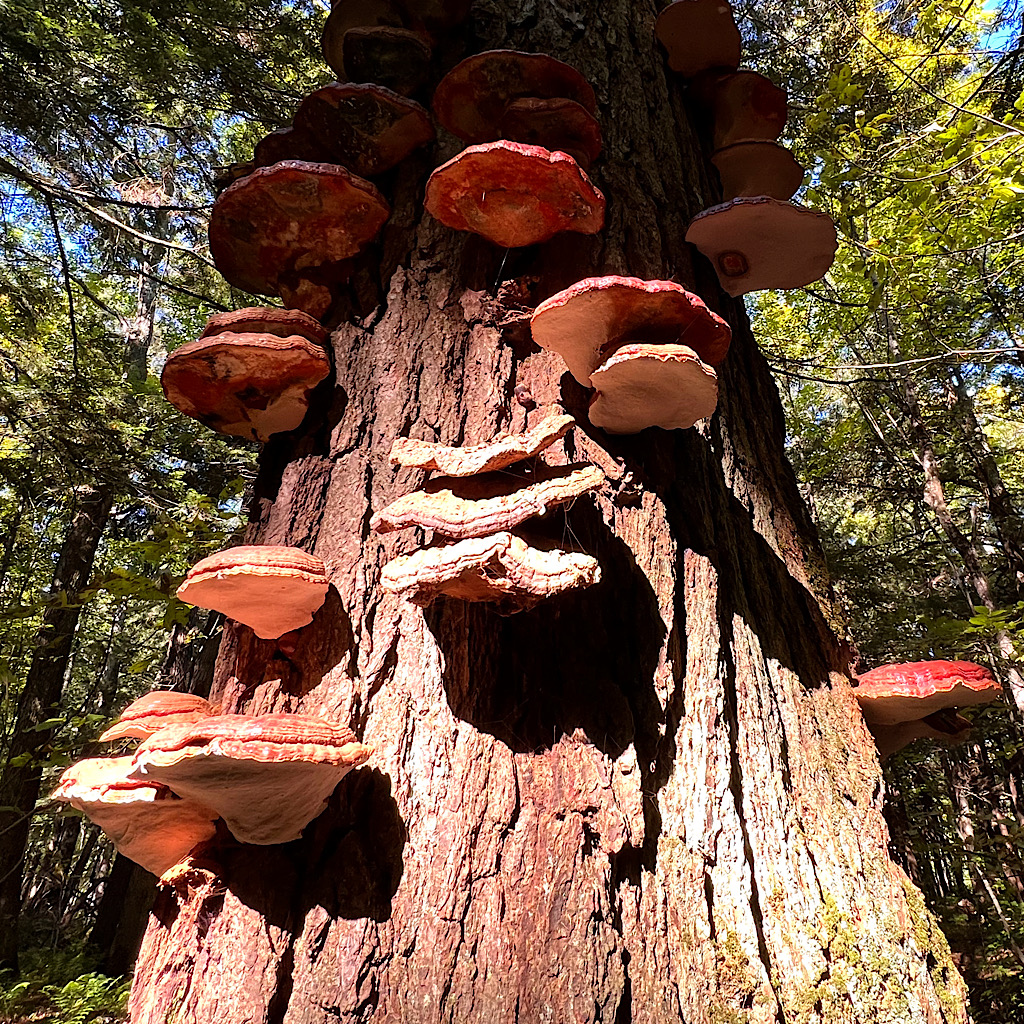
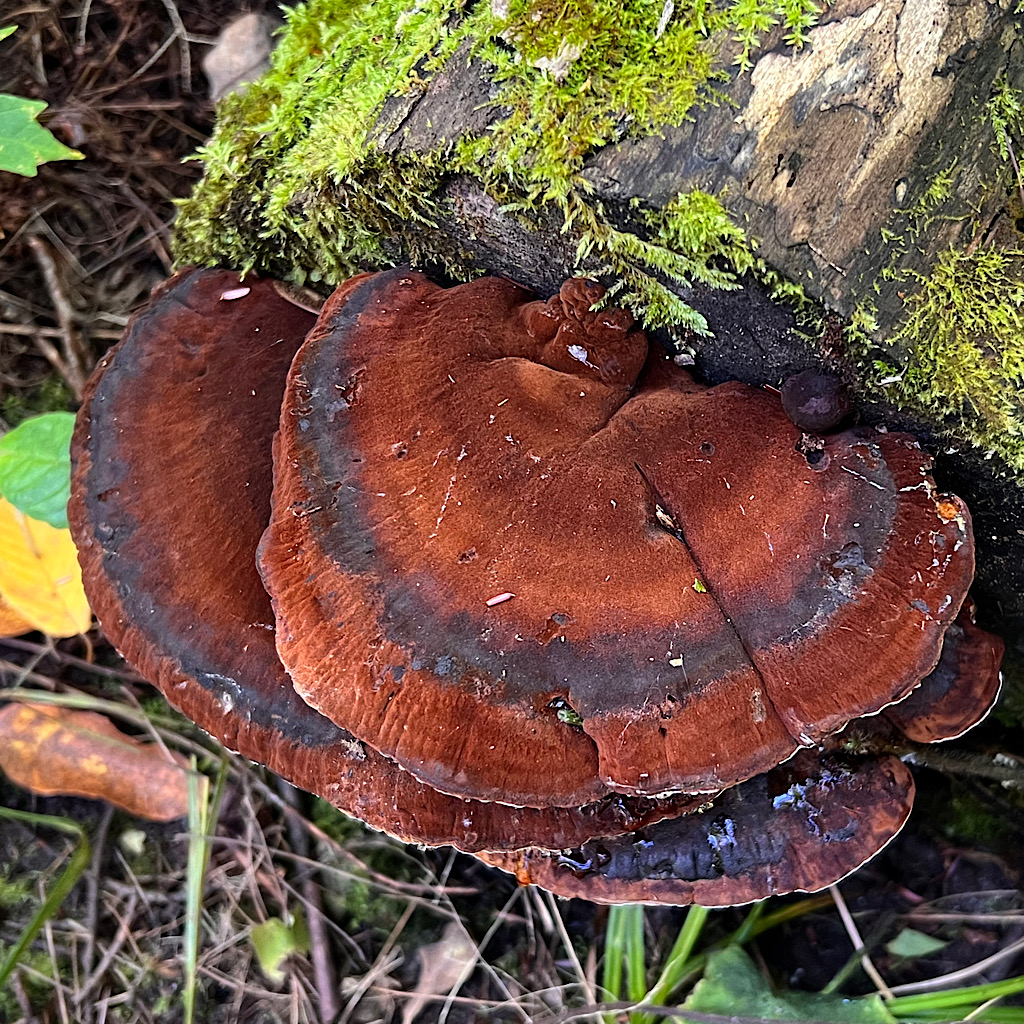
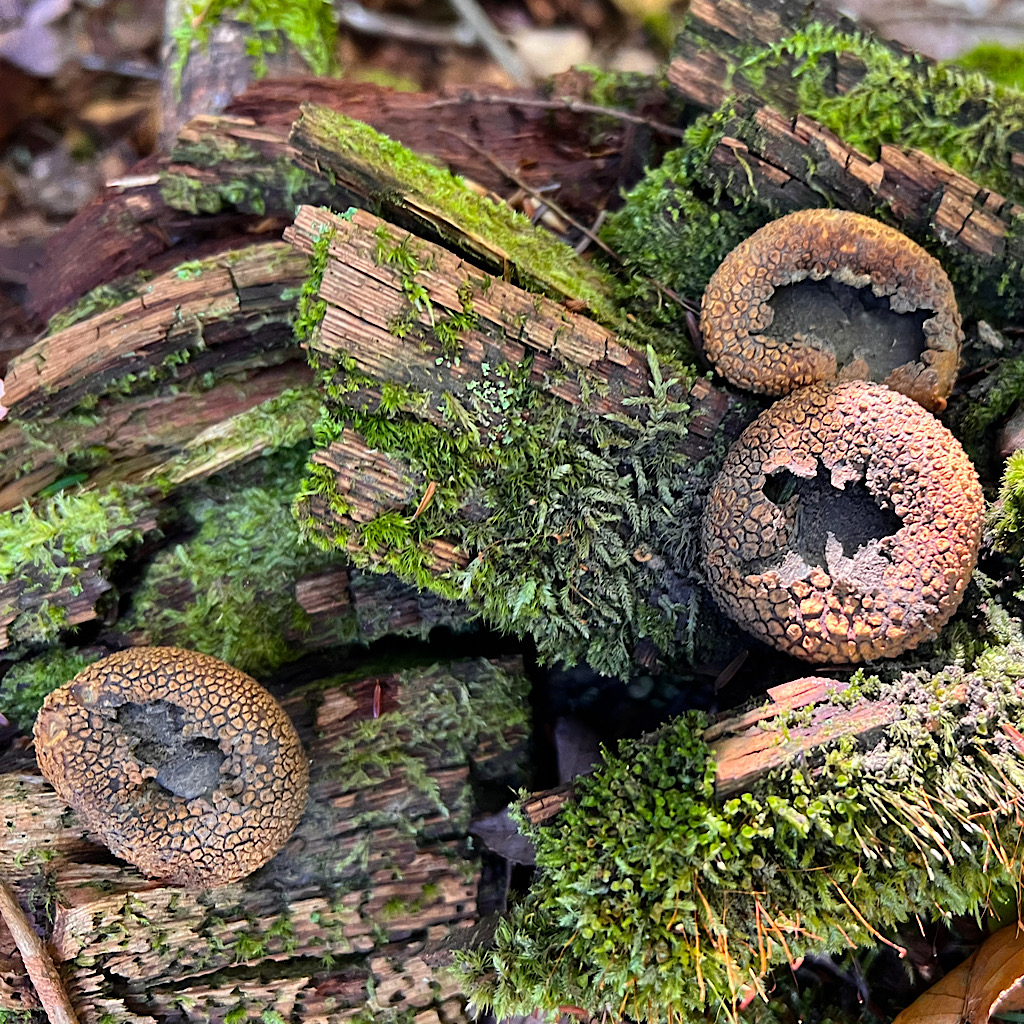
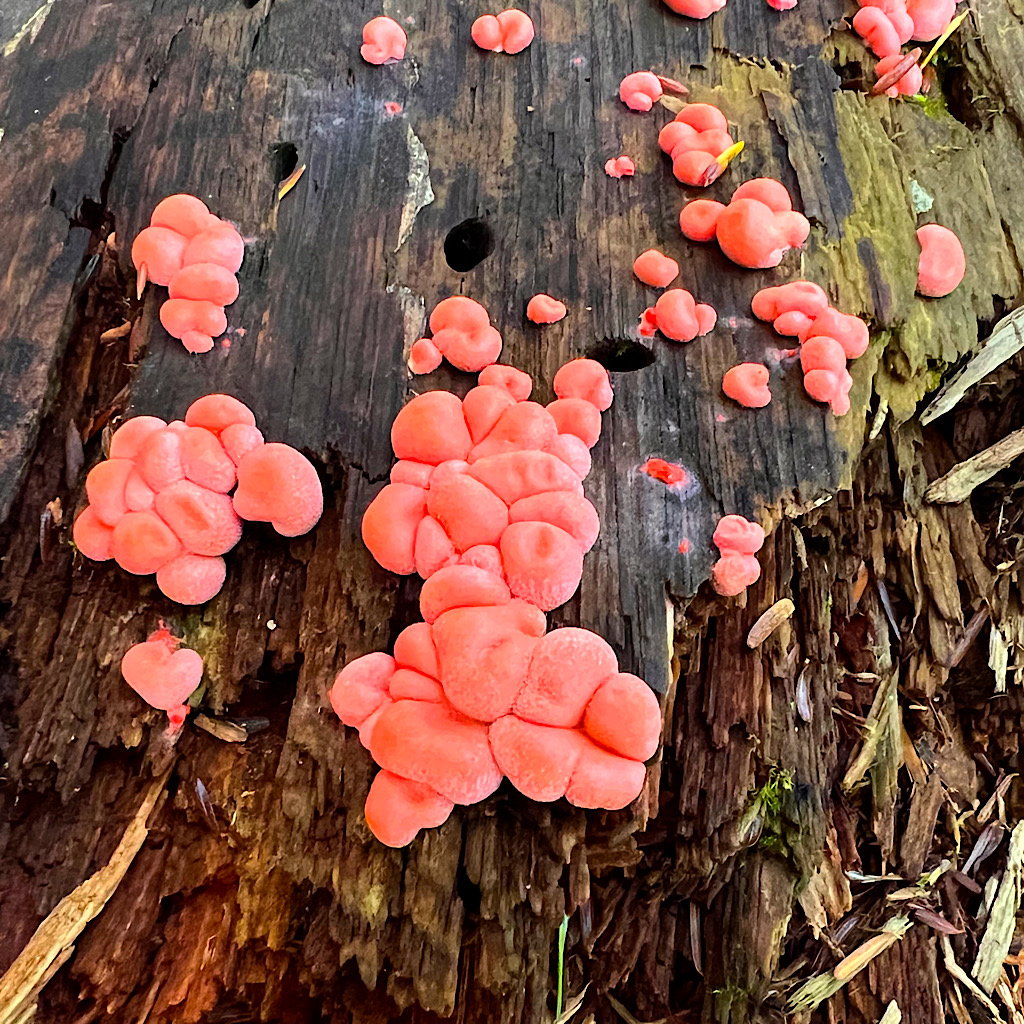
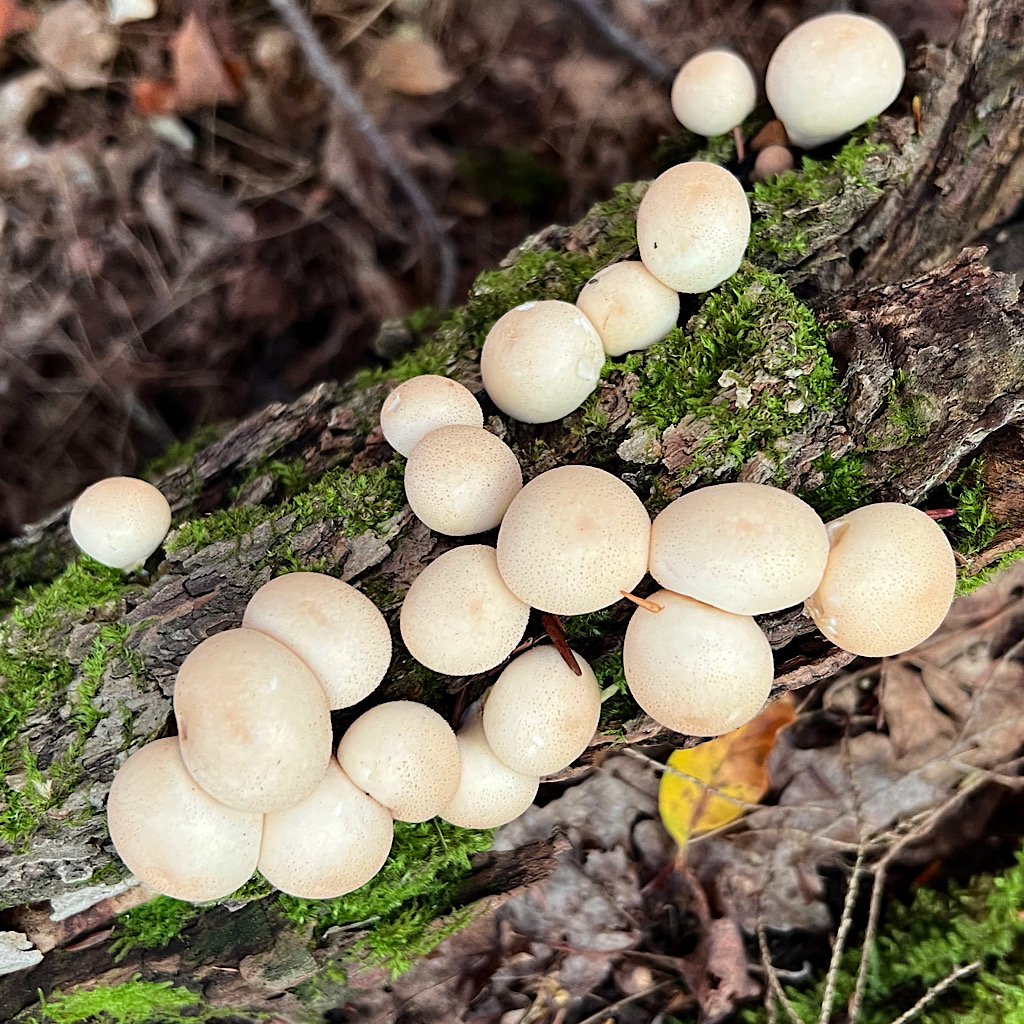
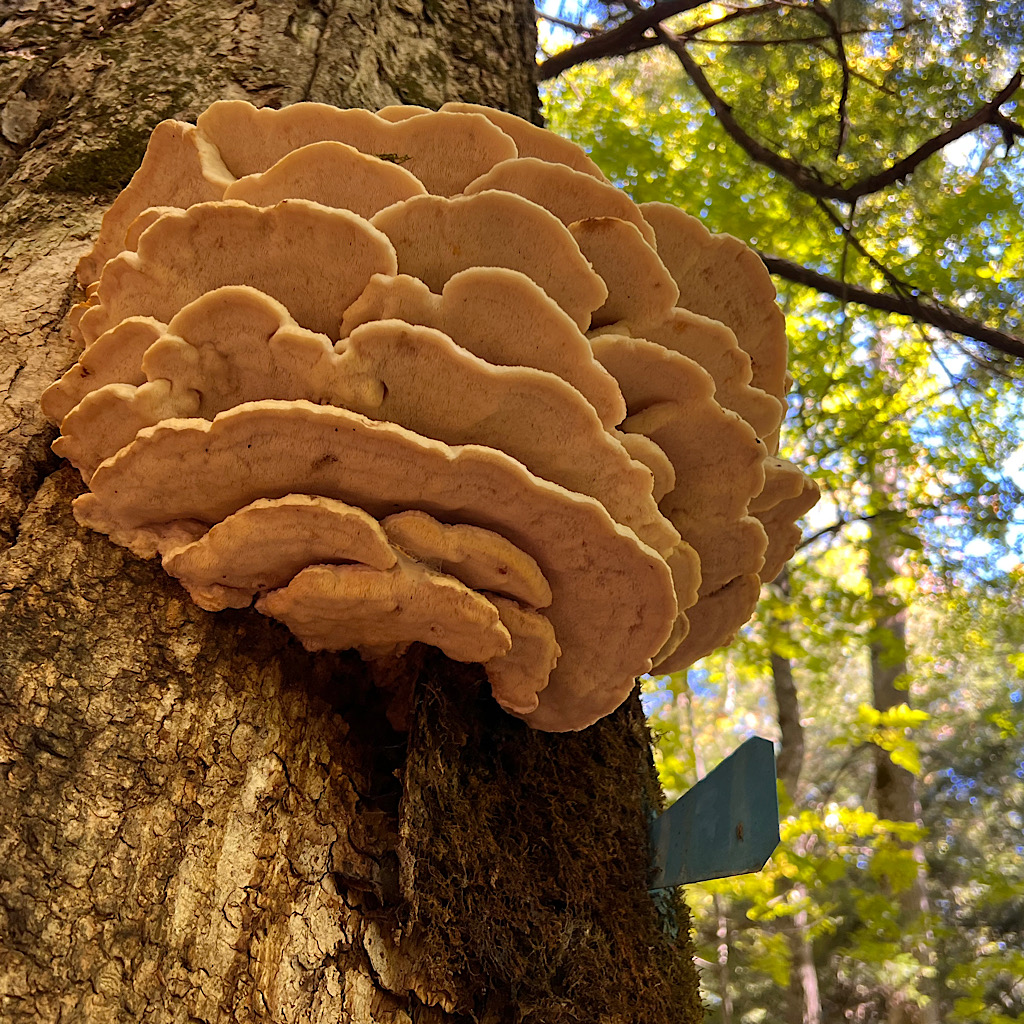
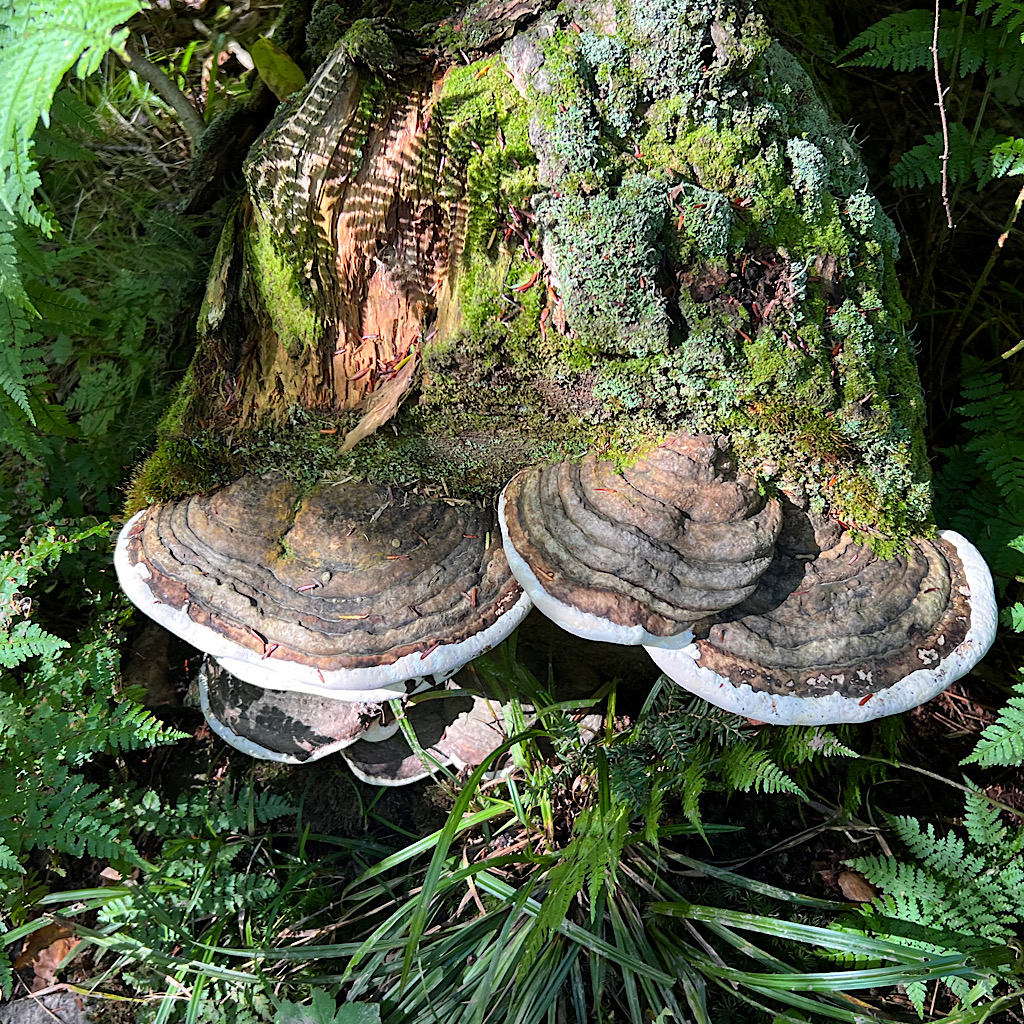
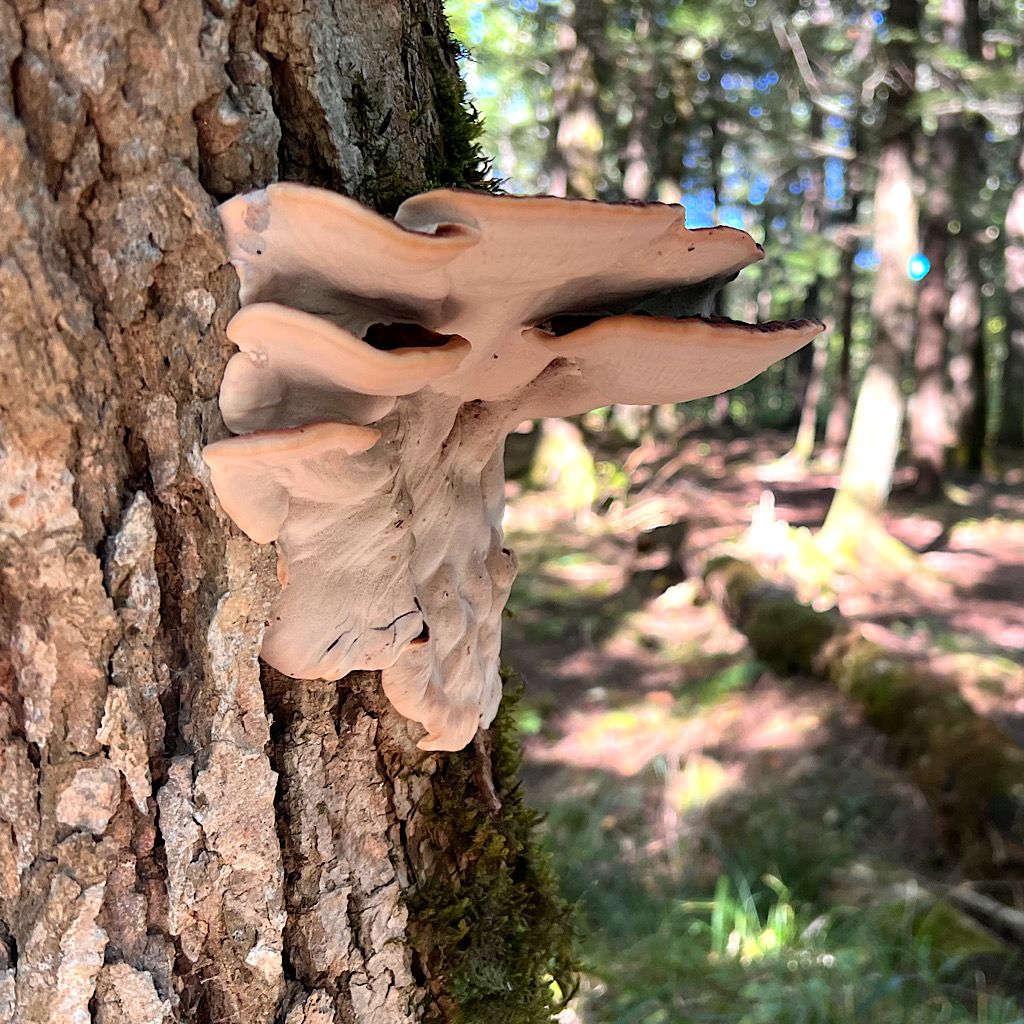
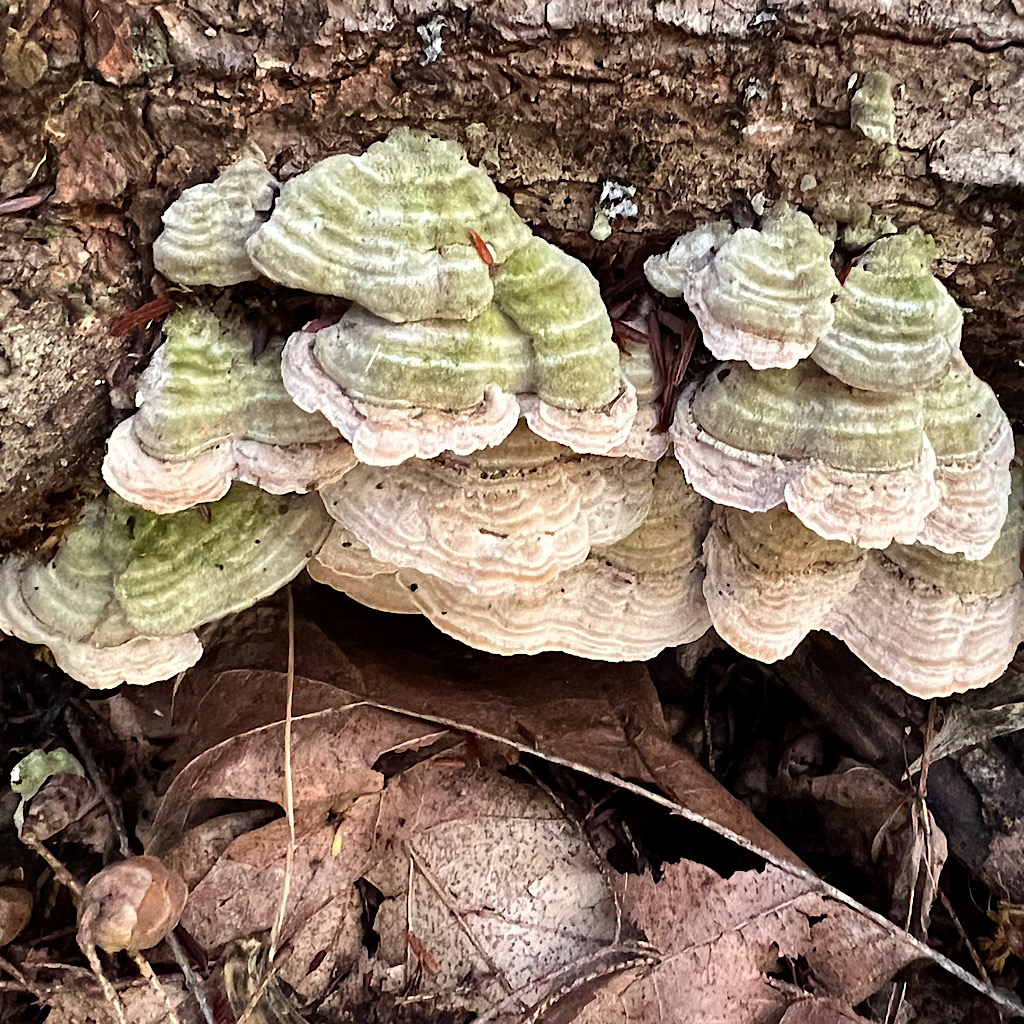
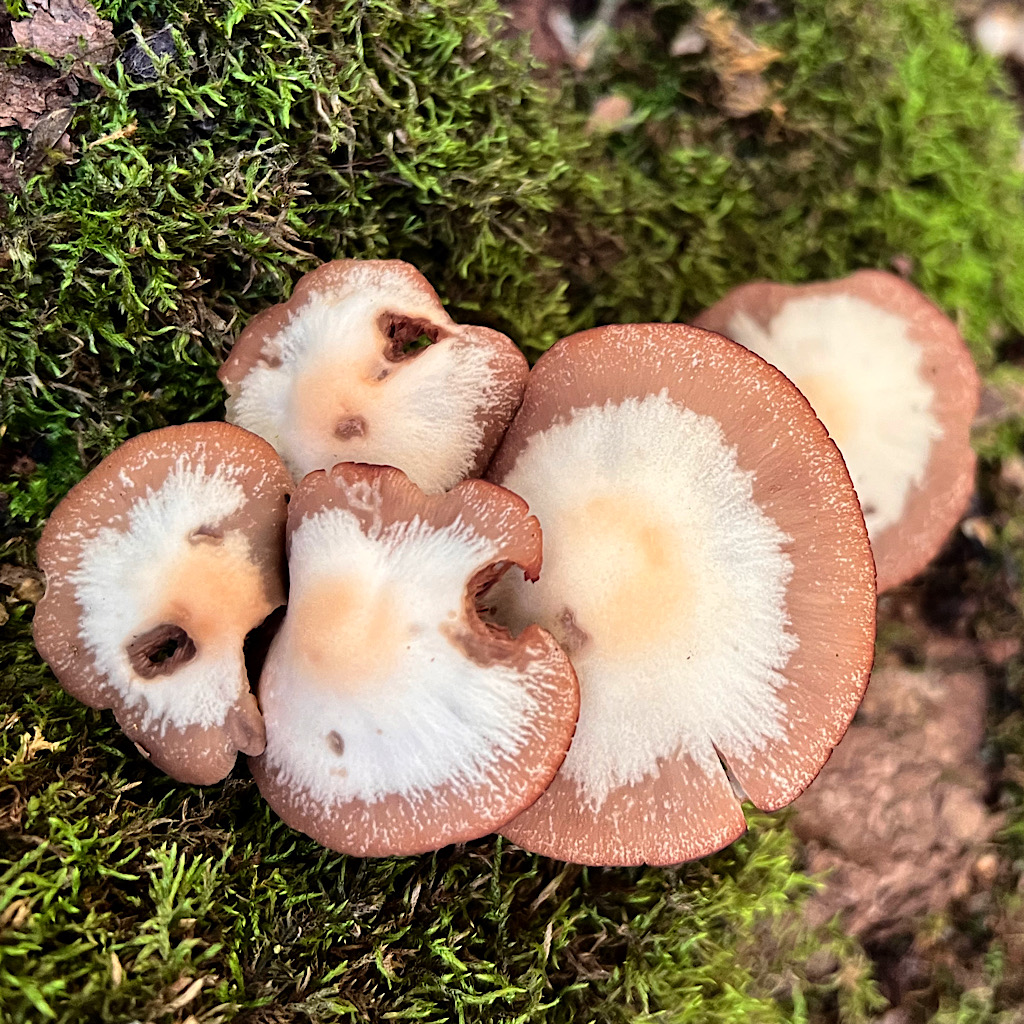
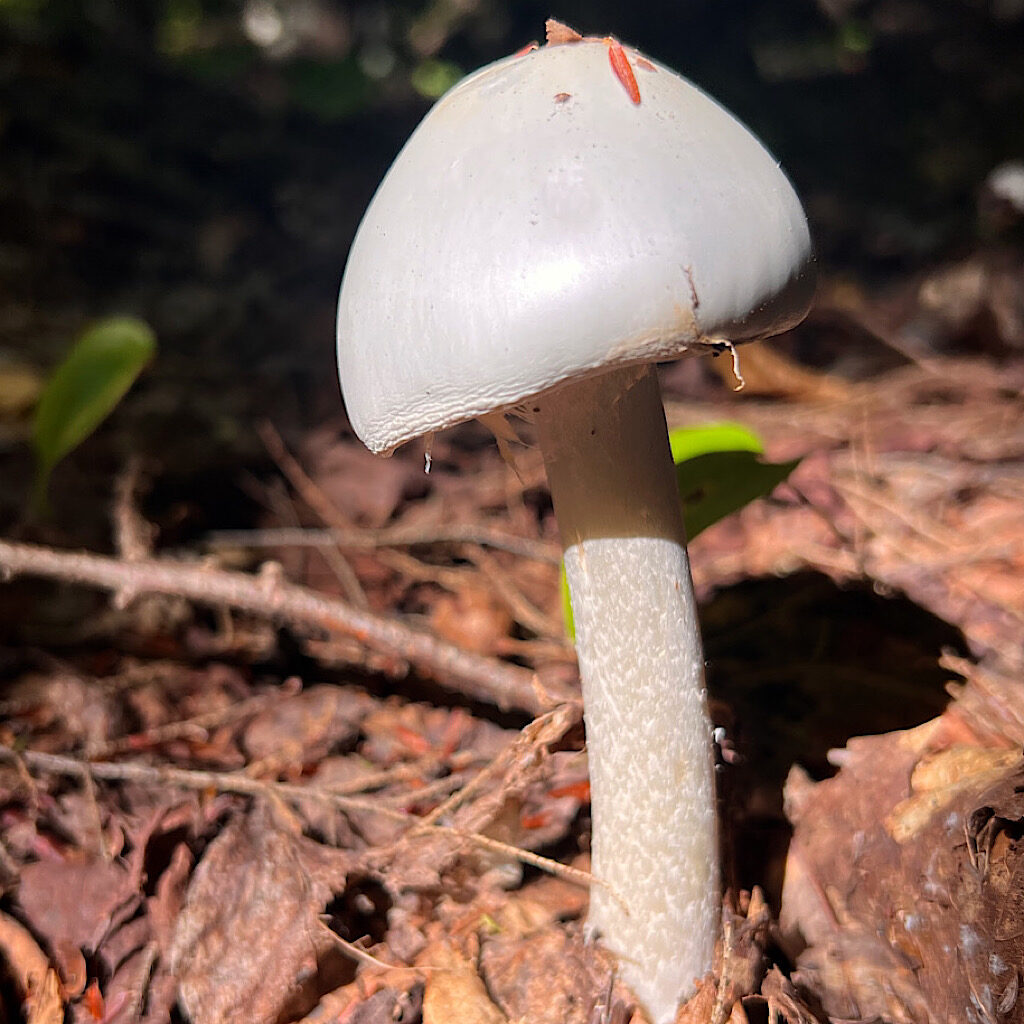
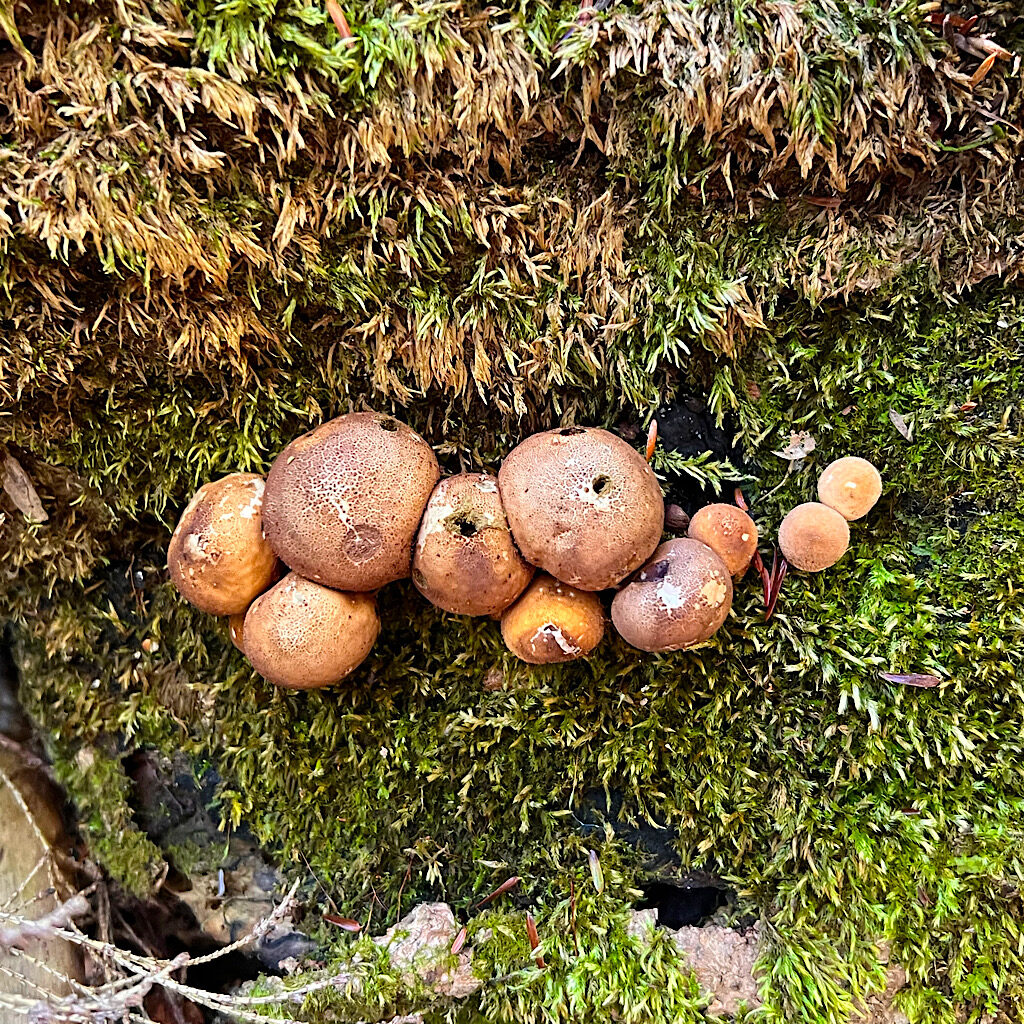
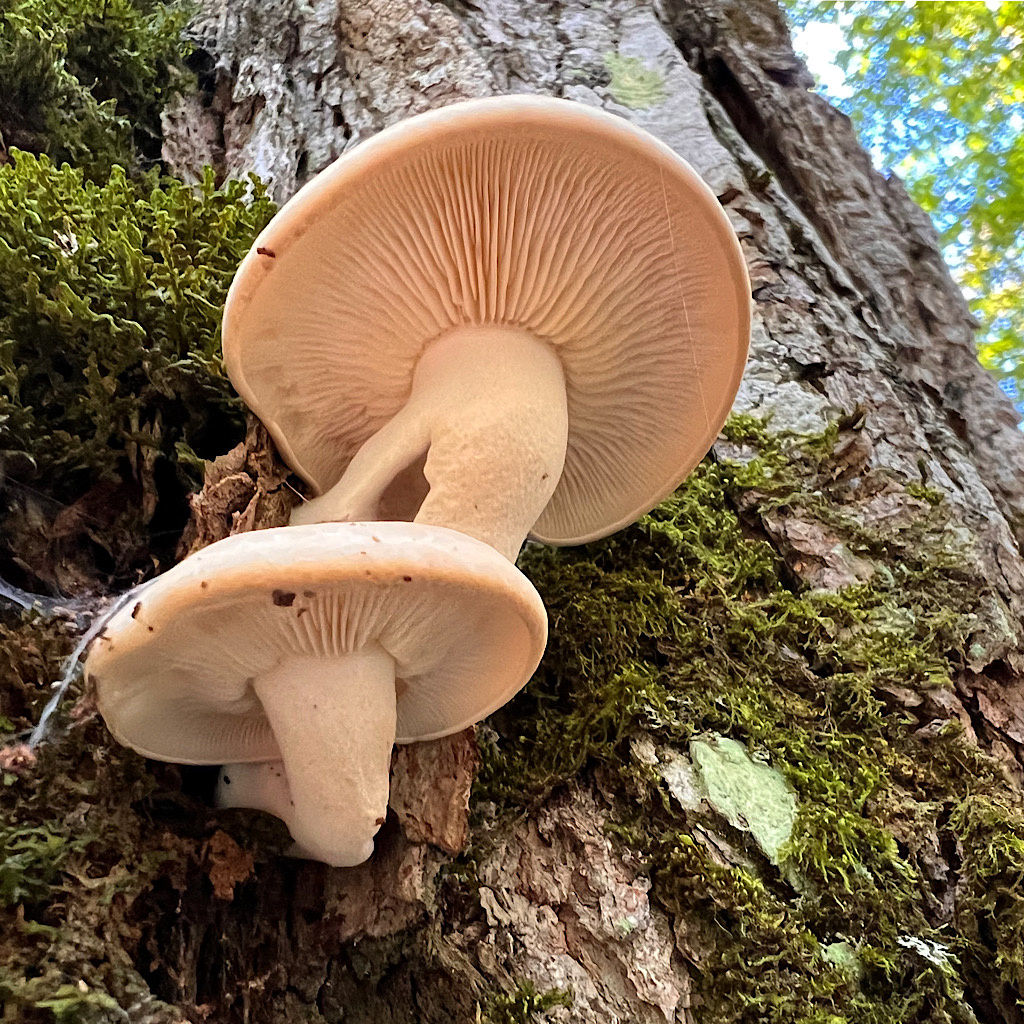
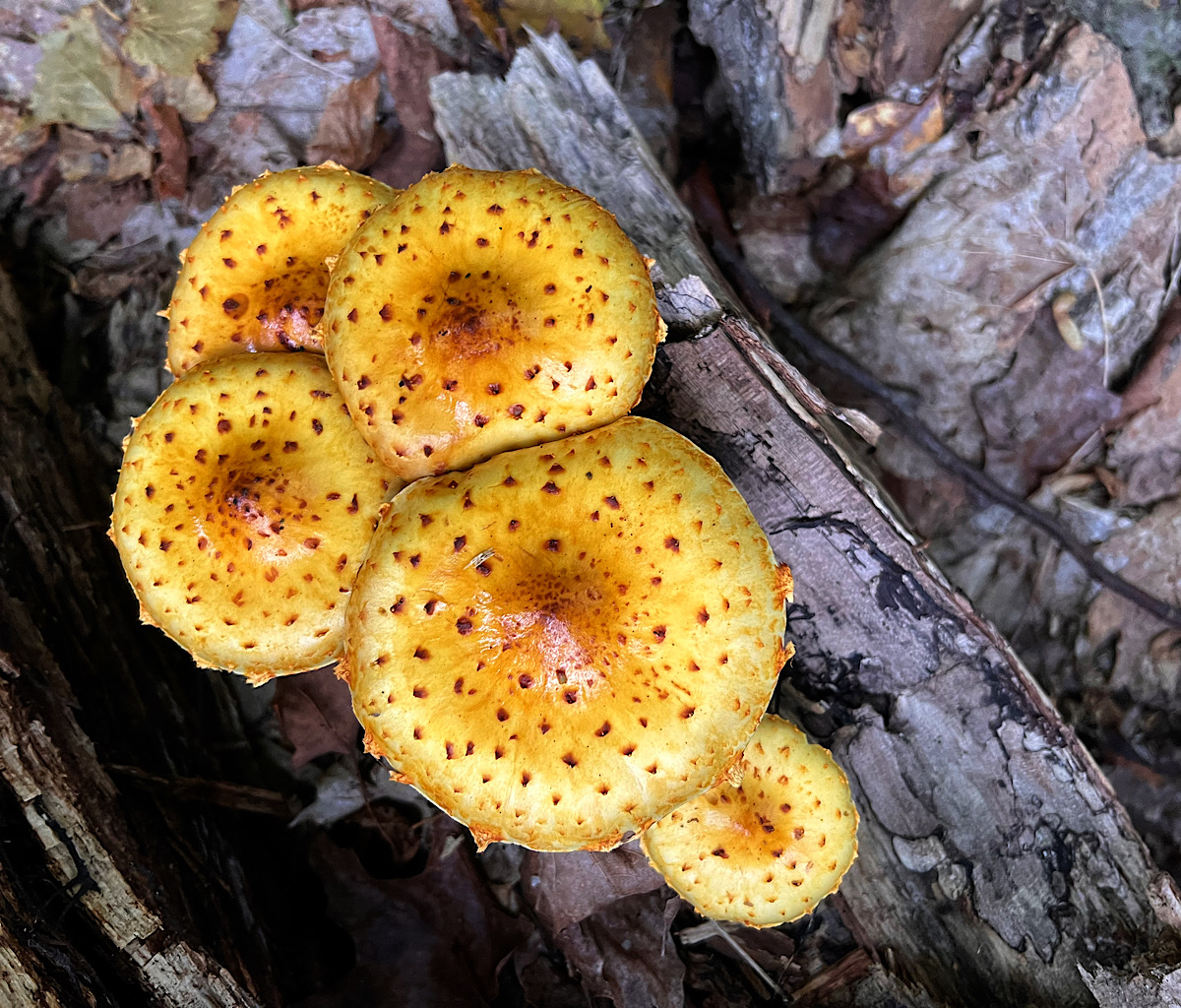
At the Visitor Center I’m told that the wolves living in the Porkies all immigrated here when the park was created, their very existence on the planet on the verge of being eradicated. I leave the talus and move deeper into the forest, my trees (I call them now) edging towards the trail where I can touch the delicate fringe of their branches.
All around me are fallen trees, left (mostly) where they fell to act as hosts for new life in the form of bugs and fungi. So many fungi in reds and yellows, orange, brown and white. Gardens spring up and nurse logs sprout infant trees. Soon, I reach the Big Carp River, secreted in a blaze of red and yellow leaves. I’m temporarily blinded by diamonds of light on the water as I navigate to a crossing and plunge into its bracing coolness. A golden crowned kinglet solos in a high coloratura above the burbling water.
I move up and down on high banks above the water, the rushing never far from earshot and begin seeing backpackers. Most are older and carrying too much. I think it’s safe to say this is a beginner backpacker’s paradise. Not too hard, but still remote and full of surprises like this wondrous forest and the birds and animals I mostly hear but never see.
Trees along the ridge are so uniform they appear planted and then come upon the biggest surprise of the day. It’s here I meet the Big Carp River and its series of falls. Flying down shapely rock called Porcupine Volcanics Andesite, there’s usually not more than 5-10 feet of drop, yet in this intimate setting of pine boughs as curtains, the effect on me is more powerful than Niagara.
Silvery cascades of cold clear water dance beneath ancient hemlock in a wonderland of sound, rushing toward Lake Superior. But not before pausing briefly in deep pools where moss clings to the stair-stepping rock in hushed shadow. Shining Cloud, Big Carp and Bathtub Falls blend together in a chain of froth, fervent and relentlessly carving the stone to a smooth slide.
As if in a trance, I walk on a beach of river-smoothed rocks, the place all to myself and wonder if tonight I’ll have a campsite near something as glorious as this. A chickadee swishes at me, Yesiree, yesireeee-ee-ee!
The many falls on Big Carp River were a highlight of my backpack trip.
Leaving the river to climb high again, I use my hands on exposed to roots to pull myself up and over towards Lake Superior. The Ojibwe named it Gitchee Gumee, which simply means Big Water. I sing Neil Diamond’s nonsense lyrics from a song of the same name as I descend to a cabin at the shore, waves lapping at a sand-bar of tumbled pebbles.
I meet a boardwalk and move down the shore through a muddy swamp of thimbleberry and aspen. Many sites appear right on a stony beach under shapely cedar. Backpackers have been hard at work building wind breaks out of driftwood. I can’t imagine staying here during black fly hatch. Every site stands empty except for one at the junction where the occupants hang clothes in every reachable branch.
A posse of three generations passes, the youngest proudly carrying bear spray and, in an earnest voice tells me he hopes never to have to use it. Much space was devoted at the Visitor Center educating us on black bears like the fact that they’re are about 20,000 living in the Upper Peninsula alone and bears have a sense of smell 2,100 times stronger than our own. As well, the now obvious plea not to feed or approach bears sits right next to a picture from the early days of the park where a mother and two cubs peer into a car window awaiting a reward.
I don’t see any trace of bears and I’m not letting them have any of my food.
The forest continues in hardwoods turning yellow, the light golden. I join the Little Carp River which also promises a trio of falls and I’m not disappointed with Traders, Explorers and Trappers one after another. Small islands of Copper Harbor Conglomerate peak out as if someone dropped a bag of rocks into concrete. Andesite wears into hexagonal and moss-festooned stairs.
I’m tired and look for my site, but briefly leave the river after a small dammed section where a great blue heron slowly flaps his majestic wings to move out of my way. The hemlock return along with miniature cones and a needle carpet. Three sites appear in a row and I wonder if it will get loud tonight.
But no one comes and I claim a soulful spot near a small falls for the night, eating dinner against a rock as the lemon-yellow leaves brighten in their reflection, charging the air with color so intense, it hums.
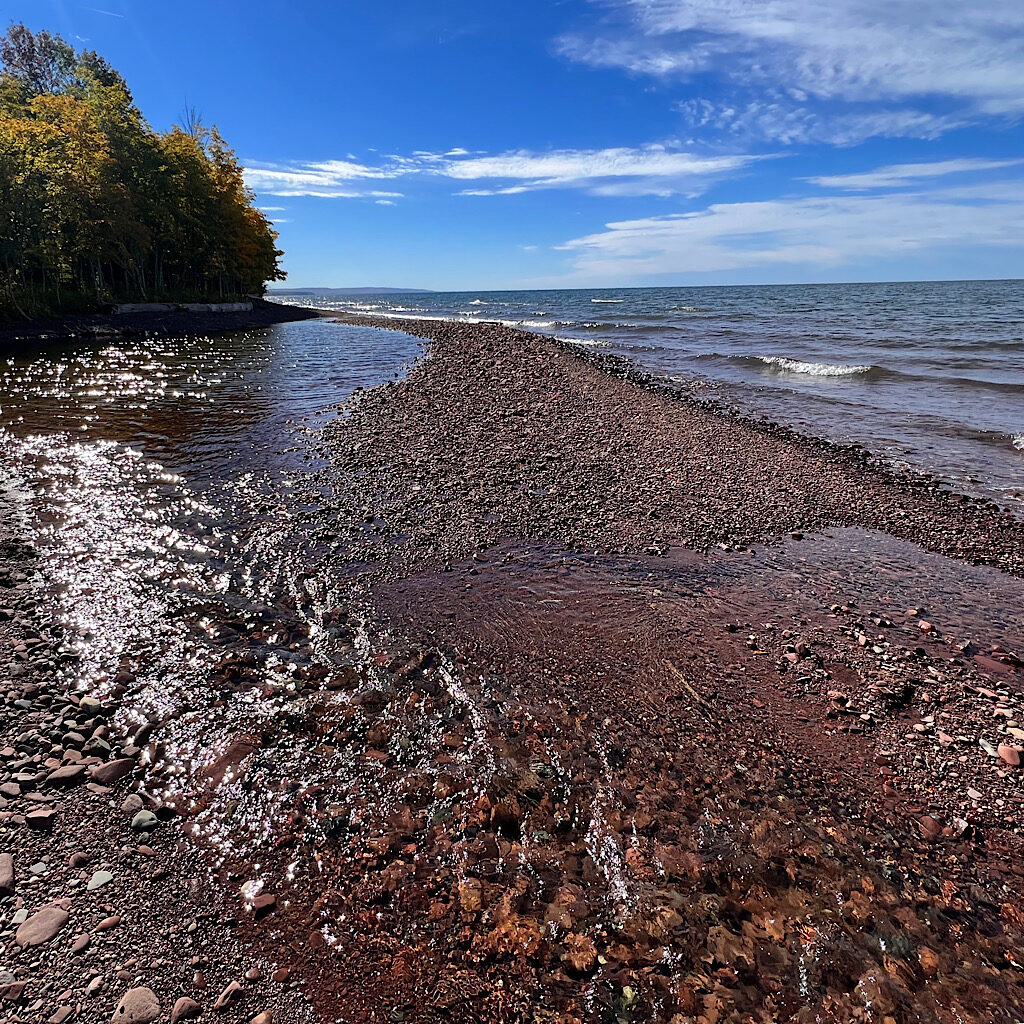
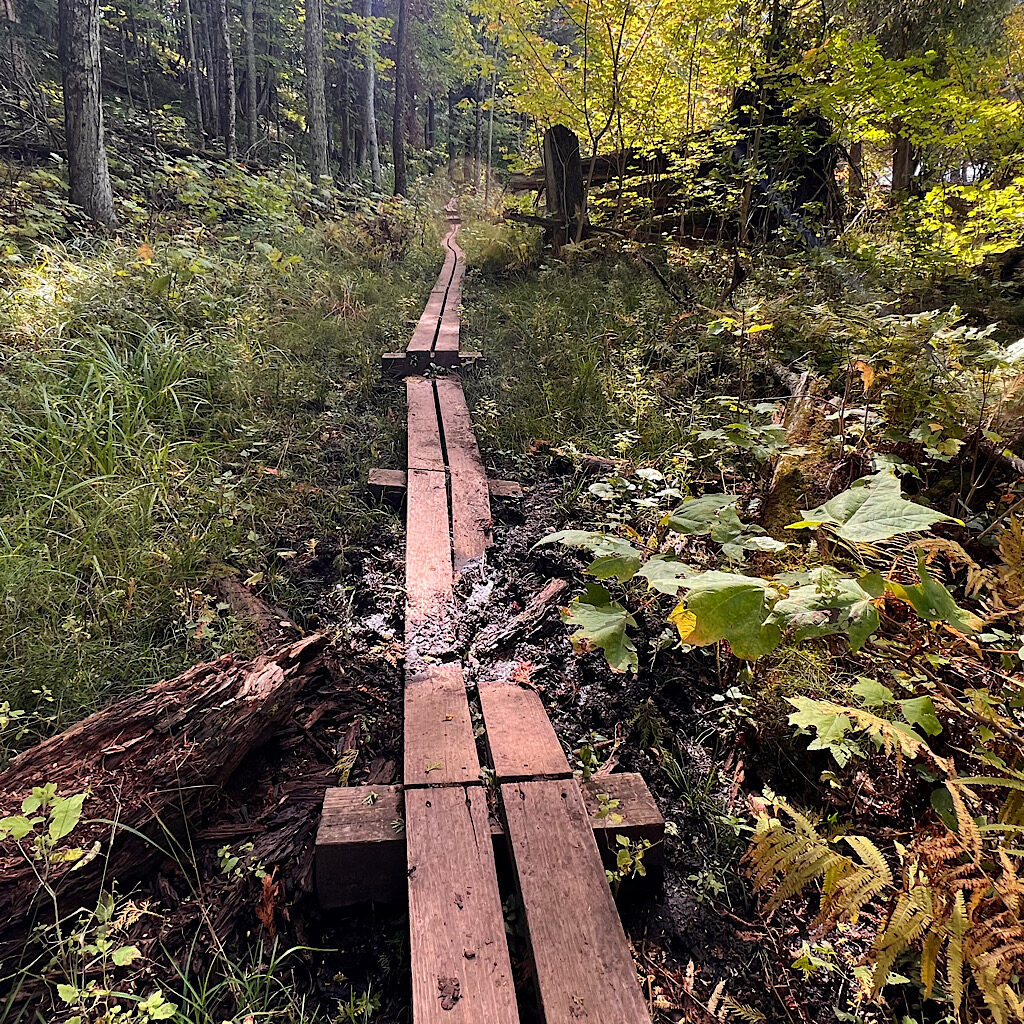
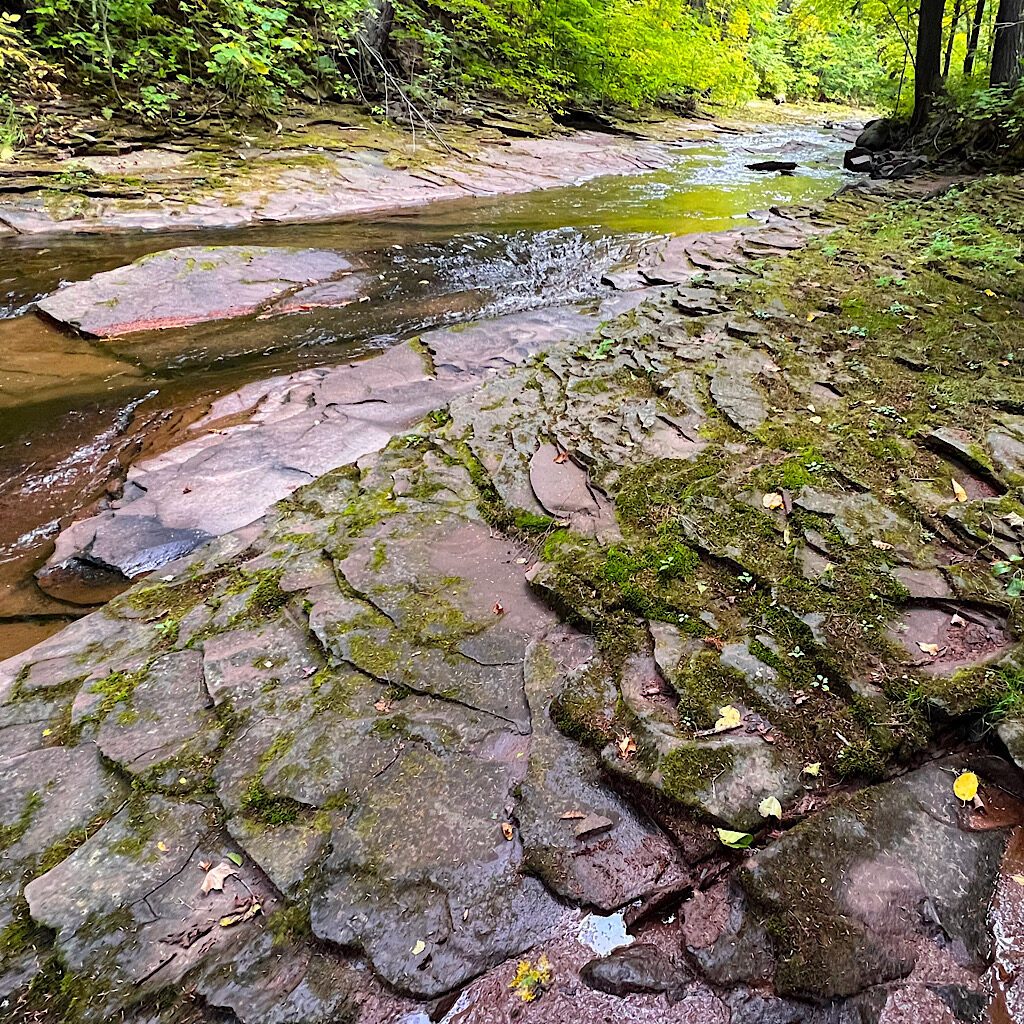
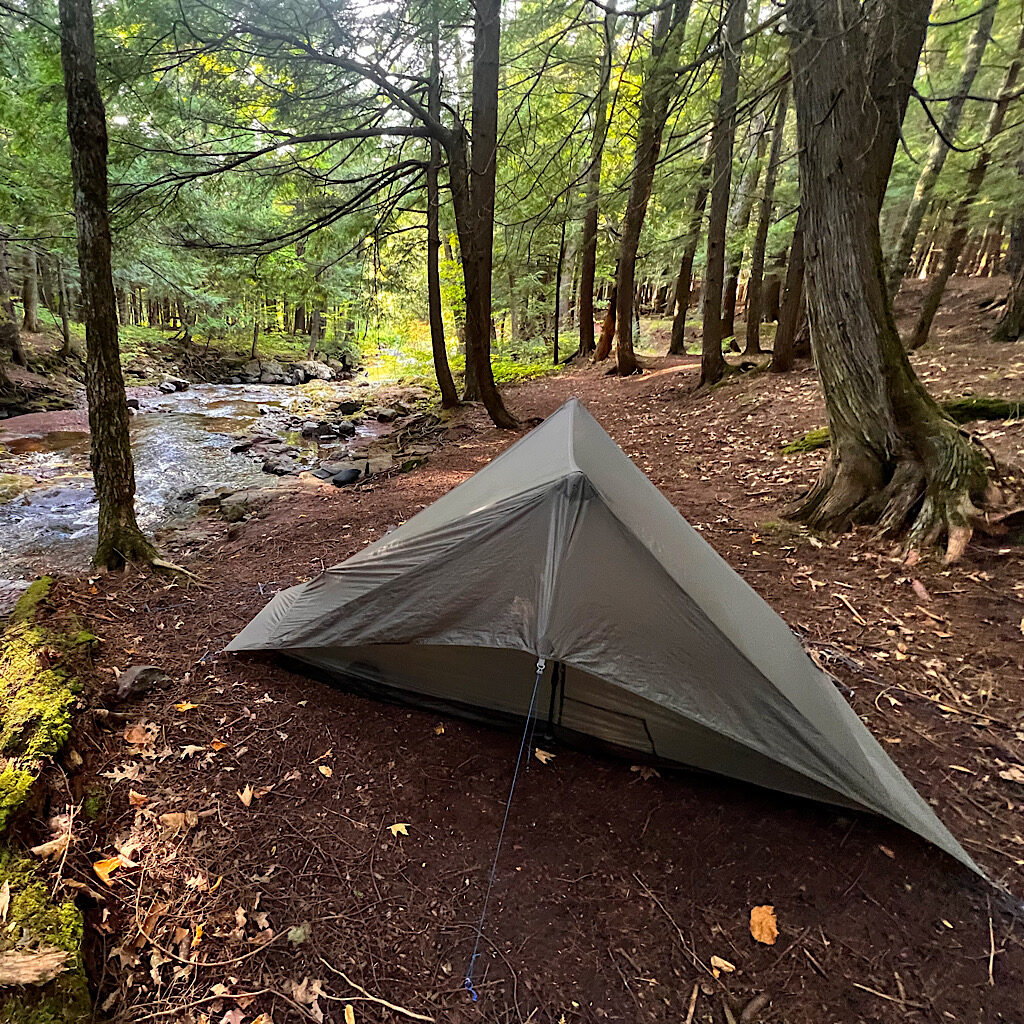
day three, LC-7 to GP-6 – 14 miles
I lie in my nest watching sunlight climb slowly up the tree trunks before breaking camp and heading off into a forest of yellowing aspen. My steps are soft on an esker avenue of hemlock. Cedar line this part of the river and I the timbre changes as I walk up the cascades. Red leaves so bright they strain the eyes are scattered along the path.
People’s voices catch me from another cabin and I ask if they might have a beer to sell. Sadly, one’s at the car. It’s too early anyway and I march on along a boardwalk crushed by ferns to Overlooked Falls, a perfect chute over a block of stone so uniform he might have worn braces in his youth.
Back in the forest, maples tower above, their yellow leaves nearly out of site. The bark peels in large folds that I could lose an arm in. A dark eyed junko snaps at me while a quarrel of white throated sparrows jabber in popcorn staccato. A downy woodpecker gives a high-pitched laugh answered by the coach’s whistle of a golden crowned kinglet.
It’s blue on blue here fringed in kodachrome. Two snakes slither away from my step but pause to take my measure, lips parted. Lily Pond appears next to another cabin, empty and locked. I stop for water at a beaver dam with its own small falls and sit near dragonflies parked on the wooden steps.
It’s a short walk now through a magical forest of stained glass color towards another parking lot and hordes of tourists heading up to Summit Peak. Made of Volcanic Rhyolite it’s the highest point in the park at 1,958 feet, made higher by a wooden lookout. Most of the way is easy on wooden stairs and platform and it’s here I run into Tawnee again.
She looks well, but tells me she gave up her hike after falling twice on the steep section at the start. Still, she met a man who snaps our picture and they both tell me I need to visit Pictured Rocks National Seashore after I finish giving me all sorts of beta on camping, trails and the sunset cruise.
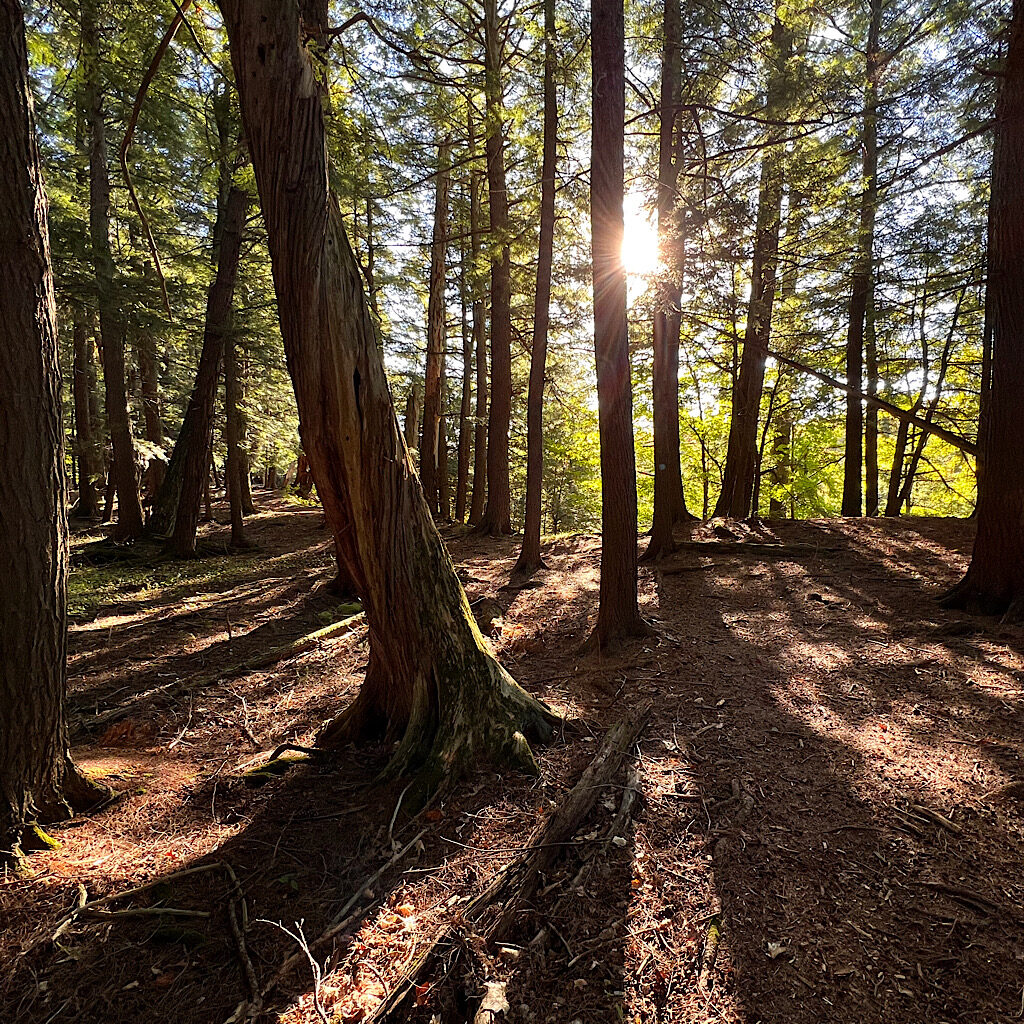
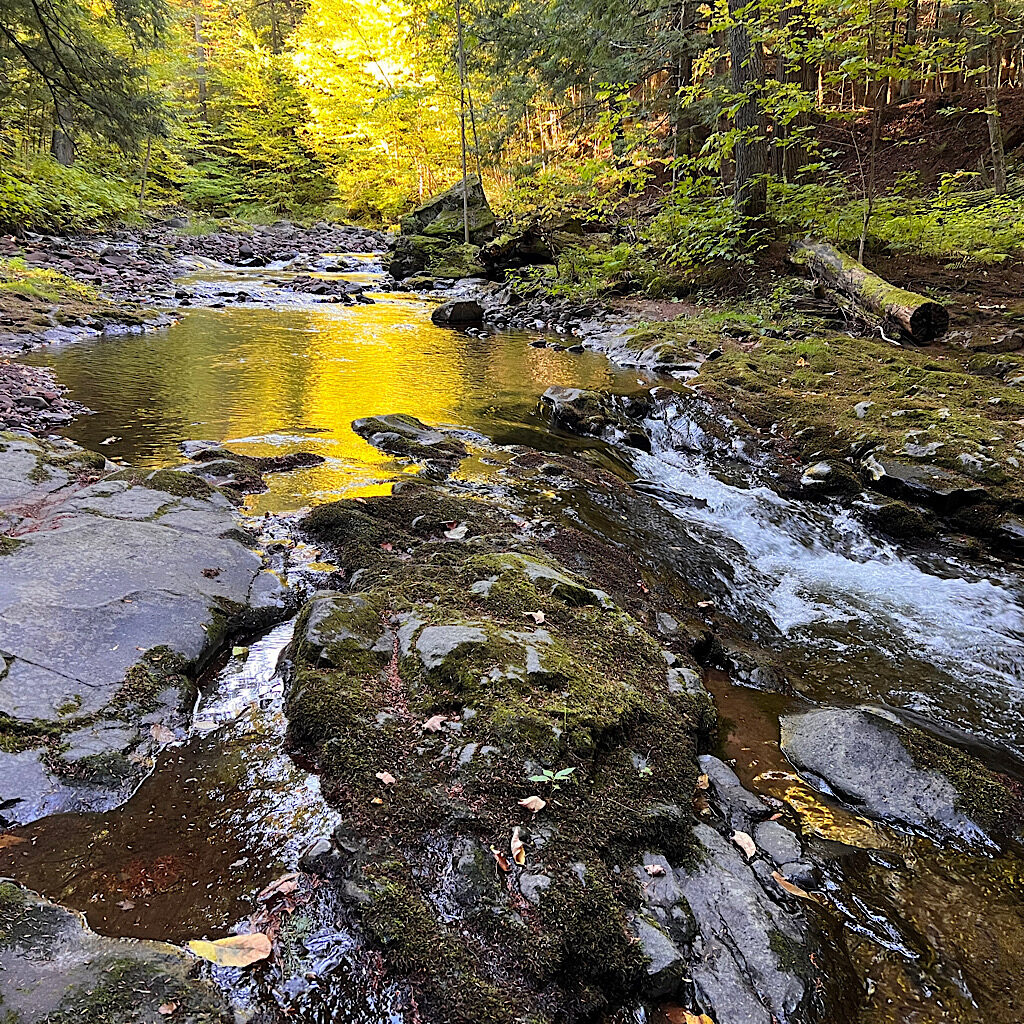
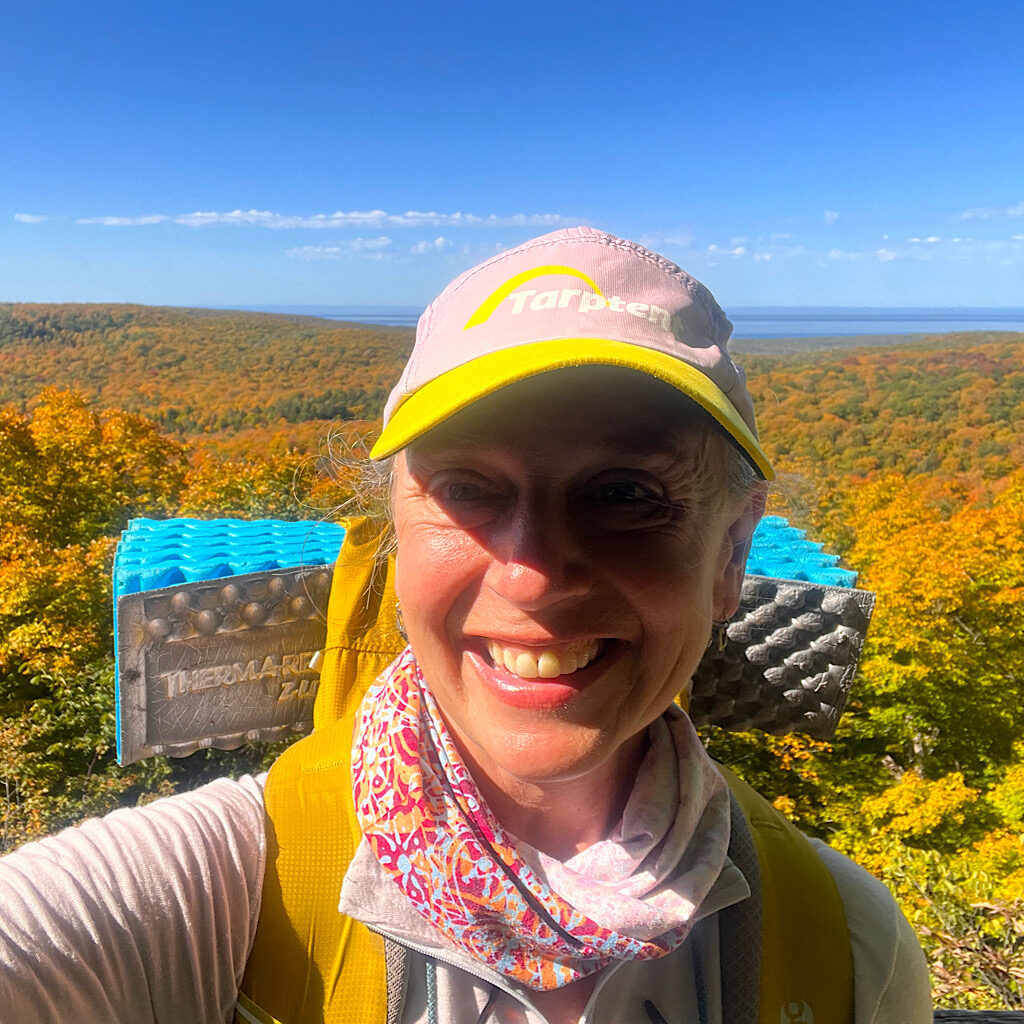
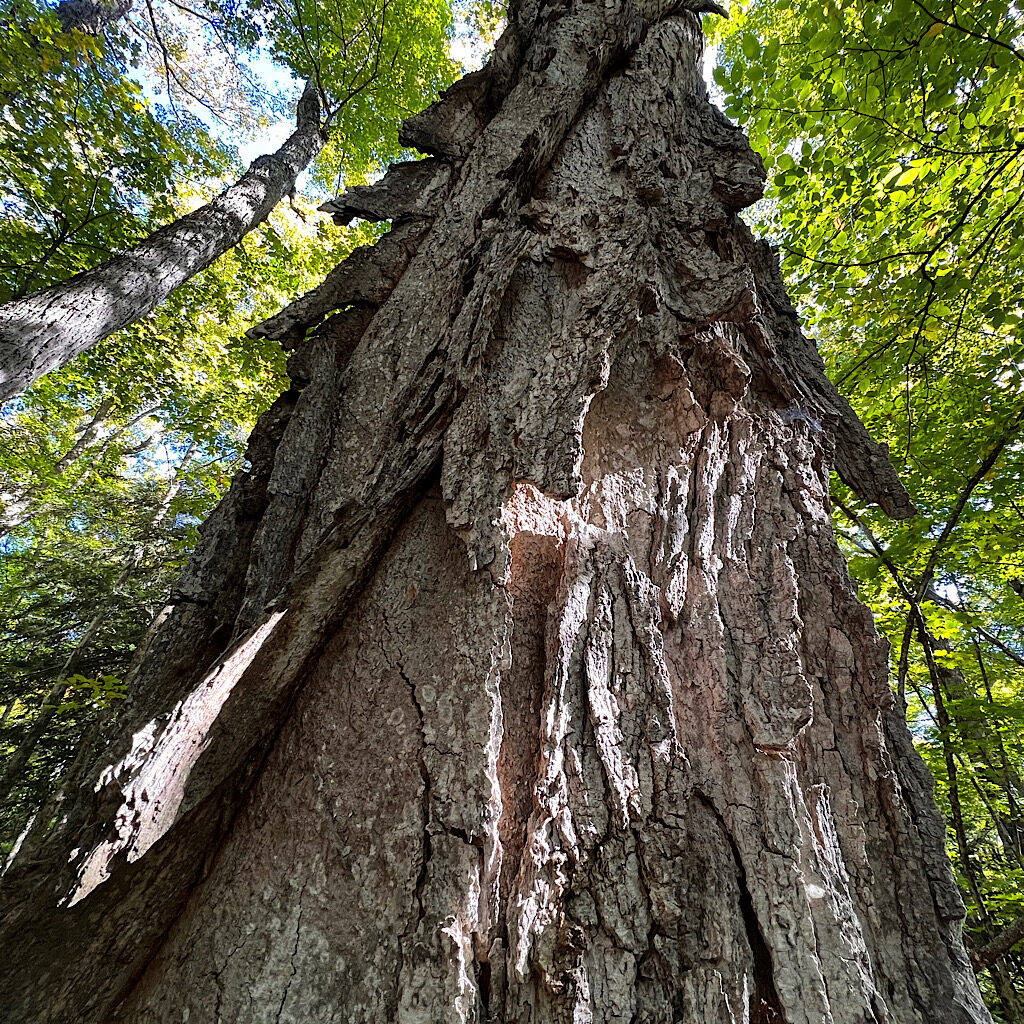
After we say goodbye and wish each other luck, I climb the tower and look out towards what I’ve walked. All I can see from here is the rocky crag of Cuyahoga Peak and a ring of fiery maples hiding Lake of the Clouds. It’s a steep descent to more forest, then another short mile of birds and luminous light before reaching glorious Mirror Lake.
Again, I feel fortunate Katie dissuaded me from staying. Not that it’s not splendid, but it’s crowded with three cabins and seven campsites, all taken. I can hear laughter and men’s voices yelling, likely at other men standing right next to them.
It’s a boardwalk through exploding cattails and loud frogs back into deep woods where I meet many backpackers preparing for their weekend with heavy packs and slow paces. I snag some water at a muddy stream which filters to clear, crisp liquid then search out my site.
It’s perfect. Reached by a short spur, it’s a private beaver pond surrounded by a cacophony of animals. I eat leaning on a rock couch before turning in early and reading late into the night, my friends unwilling to let me sleep peacefully until the stars glow bright, reflecting back to the dark velvety sky from the still water.
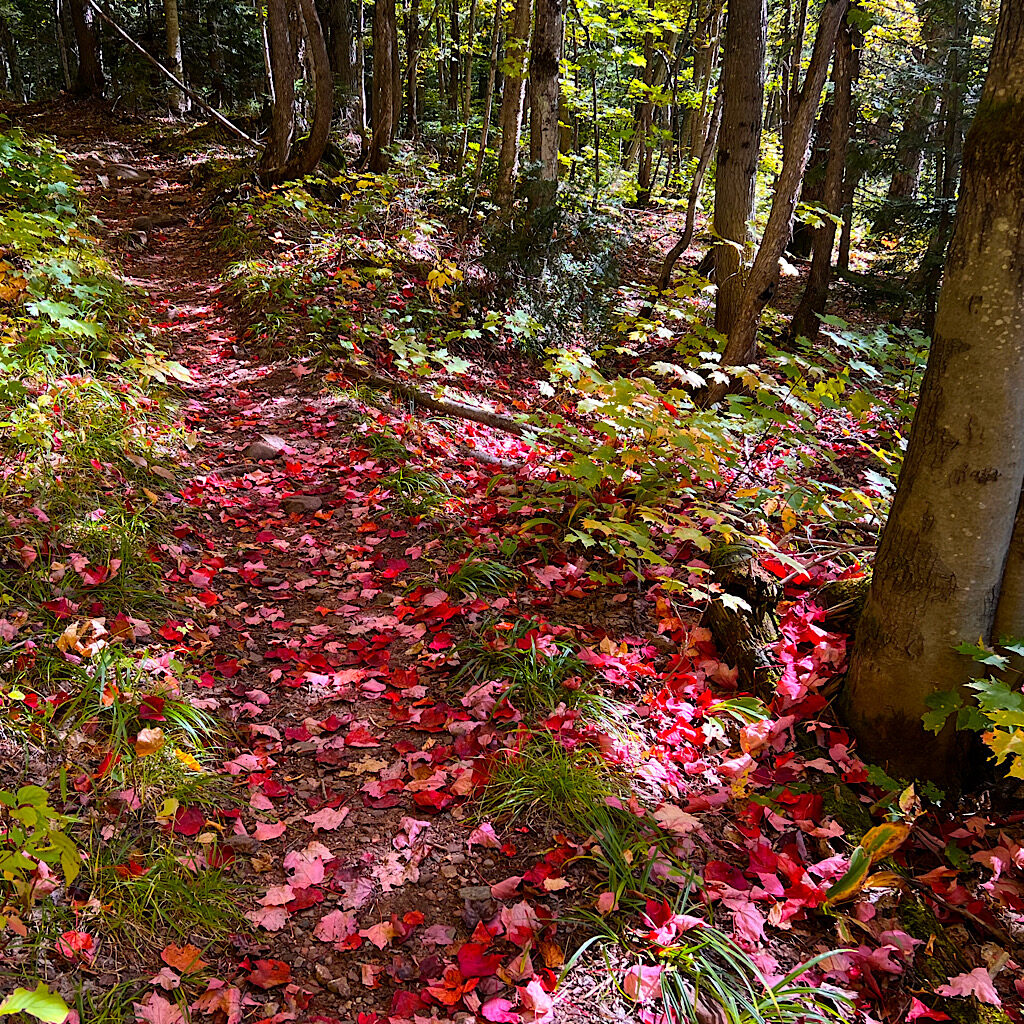
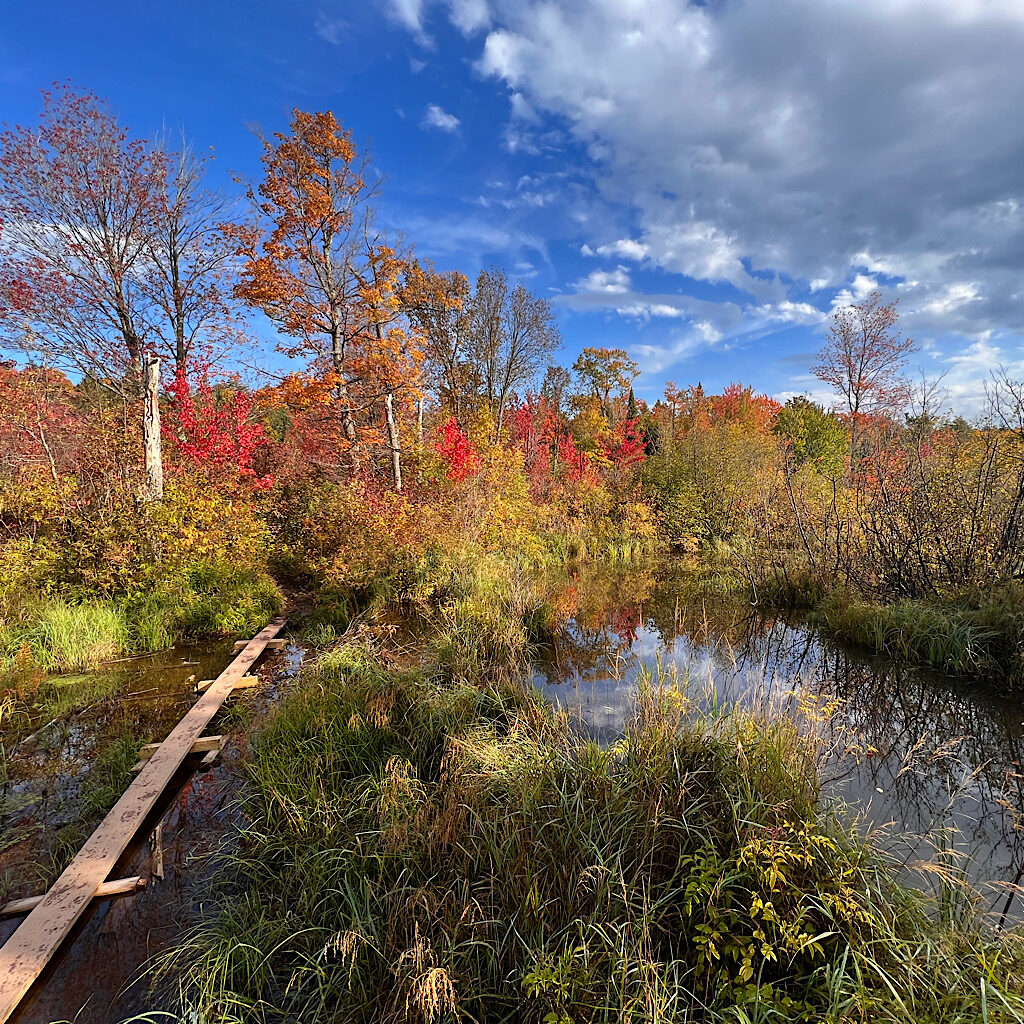
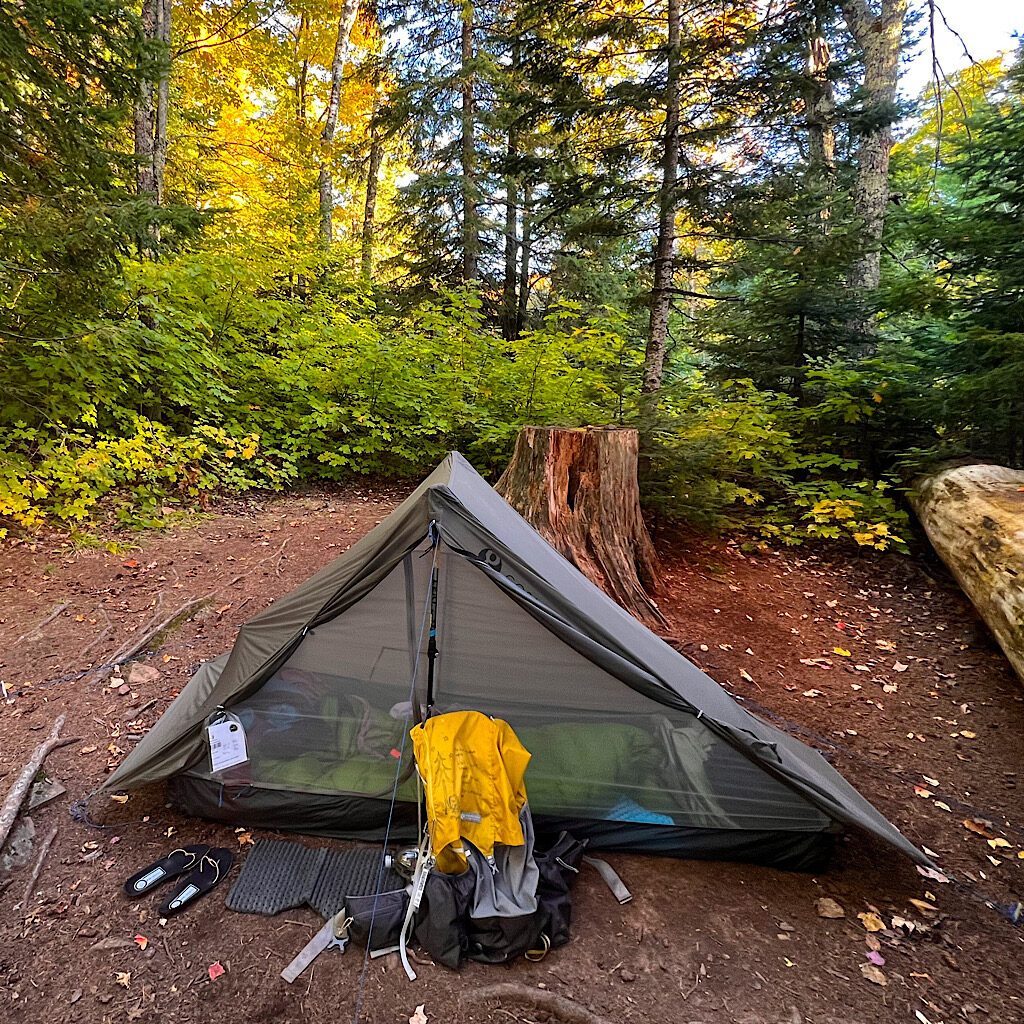
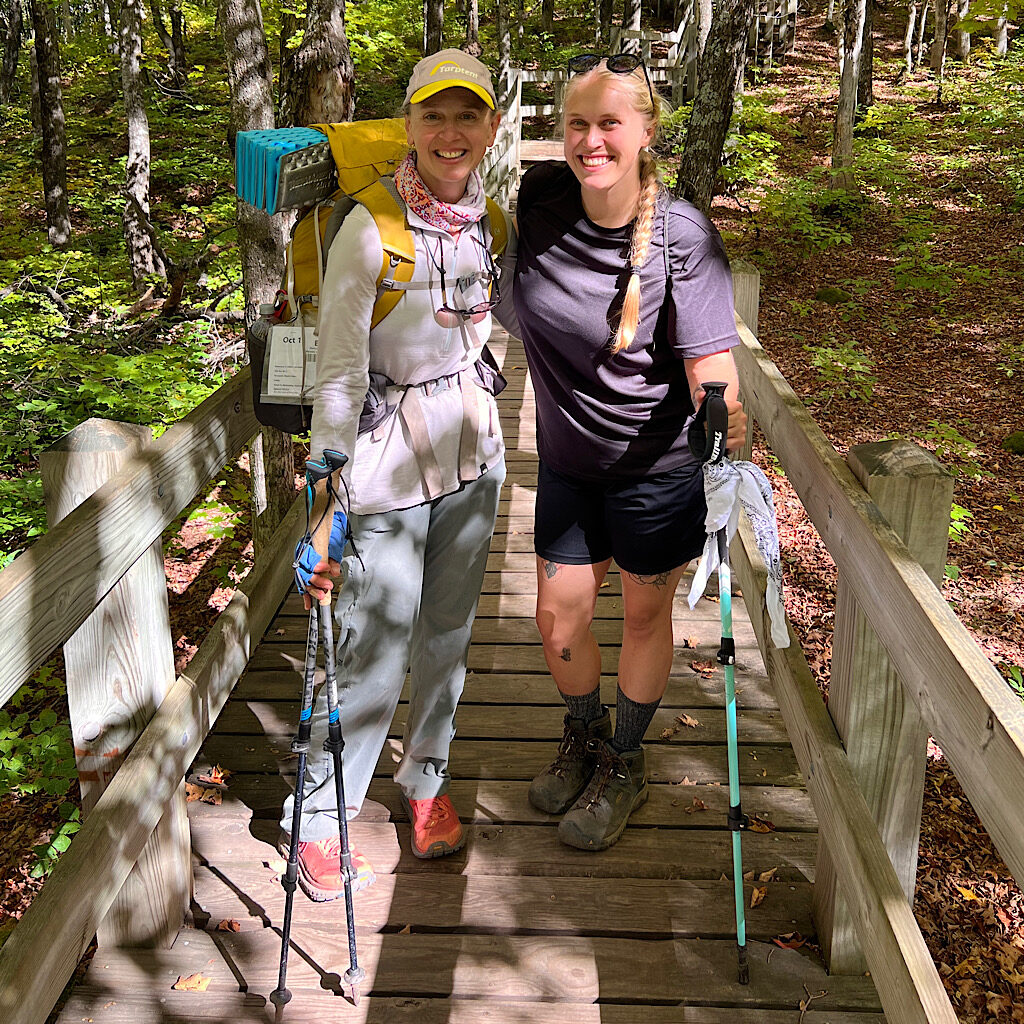
day four, GP-6 to Government Peak Trailhead – 6 miles
I lie in my sweet nest next to a private beaver pond and watch the sun catch the cardinal-red leaves at the shore’s edge. Three ducks splash into the water then cruise silently into its red and yellow middle, tipping over with butts in the air to feed.
I barely got any sleep, but what I did was delicious. It’s a climb to the top of Government Peak where two sites await their campers. The view is obscured, but I can just make out the sea of fall color reaching up and over the escarpment to the inland sea of blue.
Trap Falls is a large triangular spray to a large pool, but I’m mostly taken with the rapids after that rush along a flat slab of sandstone, taking a U-turn into a dark cavernous overhang of rock before slaloming toward a series of leaf-strewn basins.
There’s something about fall that touches every sense, reminding me of the brevity of life in its audacious celebration of death. I breathe it in, take pictures, touch, see, taste and listen.
Another beaver pond, the thick forest and then, I’m out.
epilogue and tips
What a trip! I got to the Porkies at the best time just as the leaves started changing and the air was still warm, the sun making everything glow. It’s not easy to find precisely the right time to visit, but I can’t imagine walking through in rain or slapping away mosquitos while savoring the waterfalls. That being said, if it was a bit warmer, I would have been in those falls and planned a far leisurely time to do so.
Here are a few tips to plan your trip:
- location: Upper Peninsula, Michigan
- distance: 90 miles of trail
- difficulty: moderate
- best time to go: late summer (to avoid black flies) and fall but the trails are hiked all year round
- highest point: 1,958 feet on Summit Peak
- lowest: Lake Superior
- type of travel: foot traffic only
- dogs: must be leashed at all times
- camping: 65 sites and 16 rustic cabins plus numerous car camping sites, more here
- cell service: spotty
- permits: All backcountry campers are required to carry and display a permit and it’s best to reserve ahead of time although you will have to pick up the actual permit at the Visitor Center, open 8am – 8pm, May 15-Oct 14. Disperse camping is prohibited.
- water: There are many water sources except on the escarpment, so plan accordingly and always filter before drinking.
- bears: While I never saw a bear, there are plenty of them unperturbed by human presence as well as all manner of clever “mini-bears’ (squirrels, chipmunks, etc). Not every site has a bear pole, so be sure to take some paracord to hang your food out of reach, ten feet high and ten feet away from a tree.
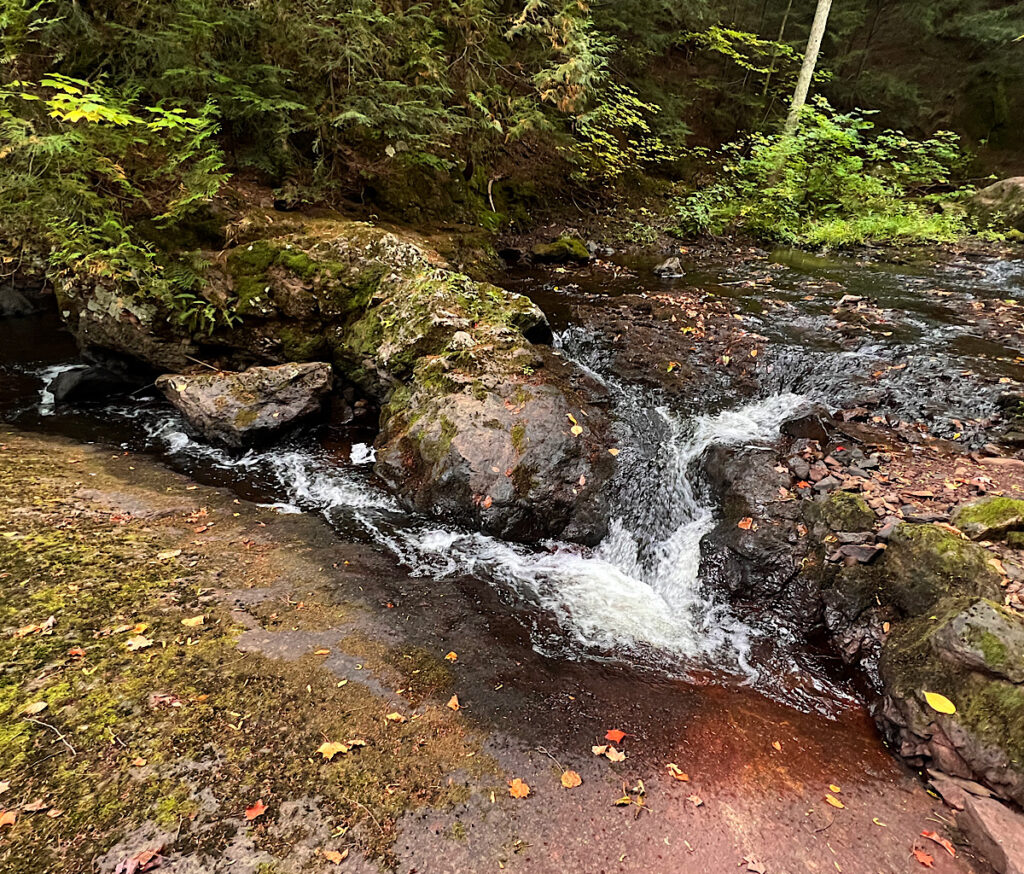
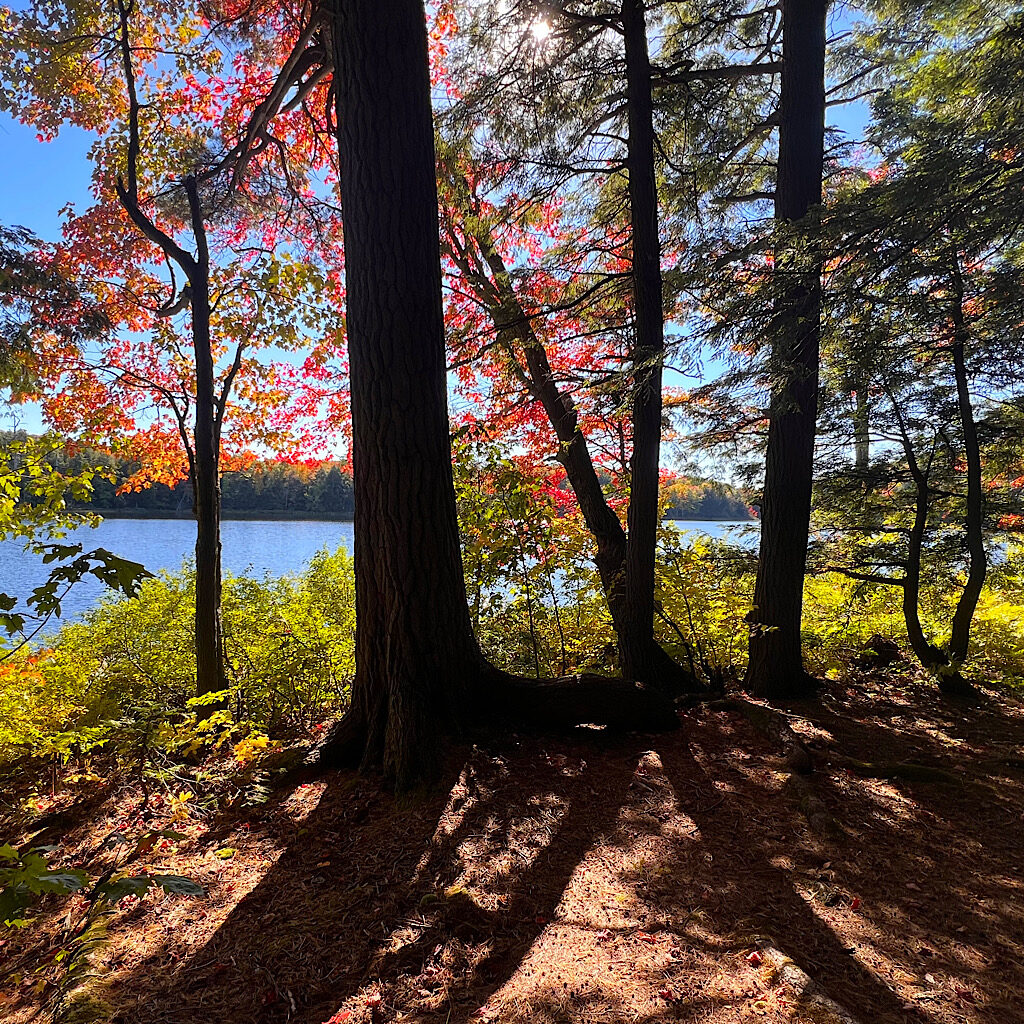
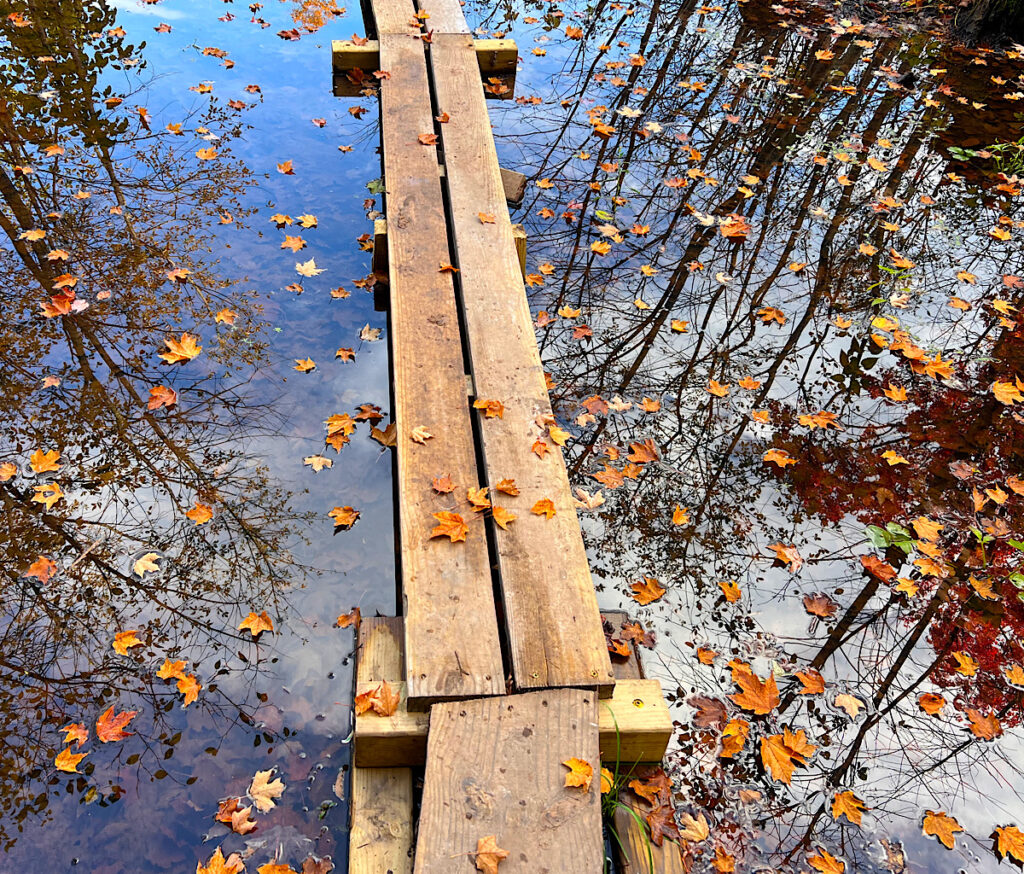


10 Responses
This made me very excited for our upcoming trip! We’ll be staying at LC 1. Do you by any chance remember what that site is like? Thank you for your great article.
fantastic! I loved my sites. I don’t precisely remember LC1 but I think it’s at a bend in the river, shaded and really nice. You ave a fire ring!